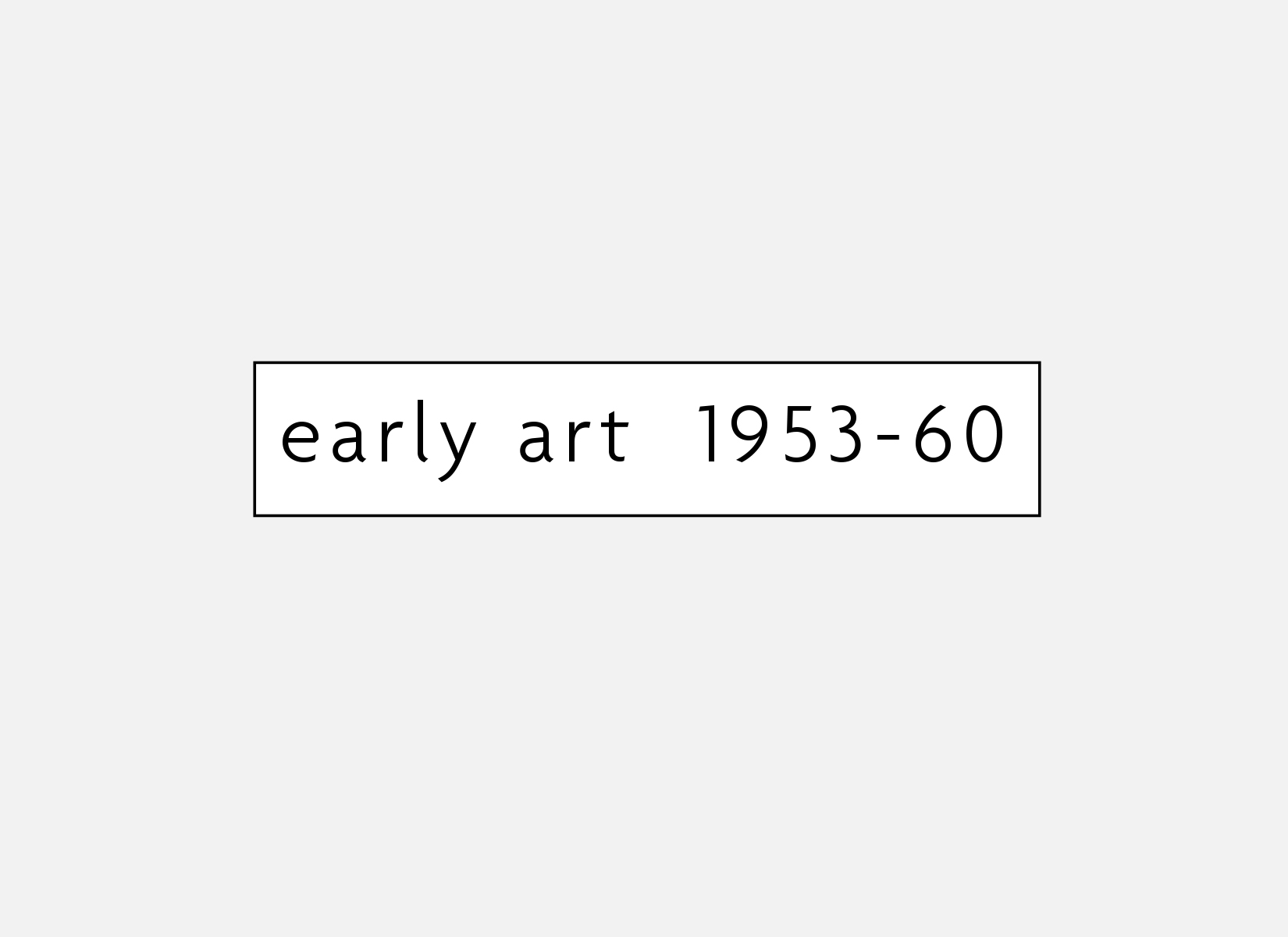

1953. Graphite on Paper. 8.5” x11”
Displaying an early ability to portray strong character in a portrait, Arran made this drawing when he was nine years old. Perhaps it shows a premonition of an earlier life.
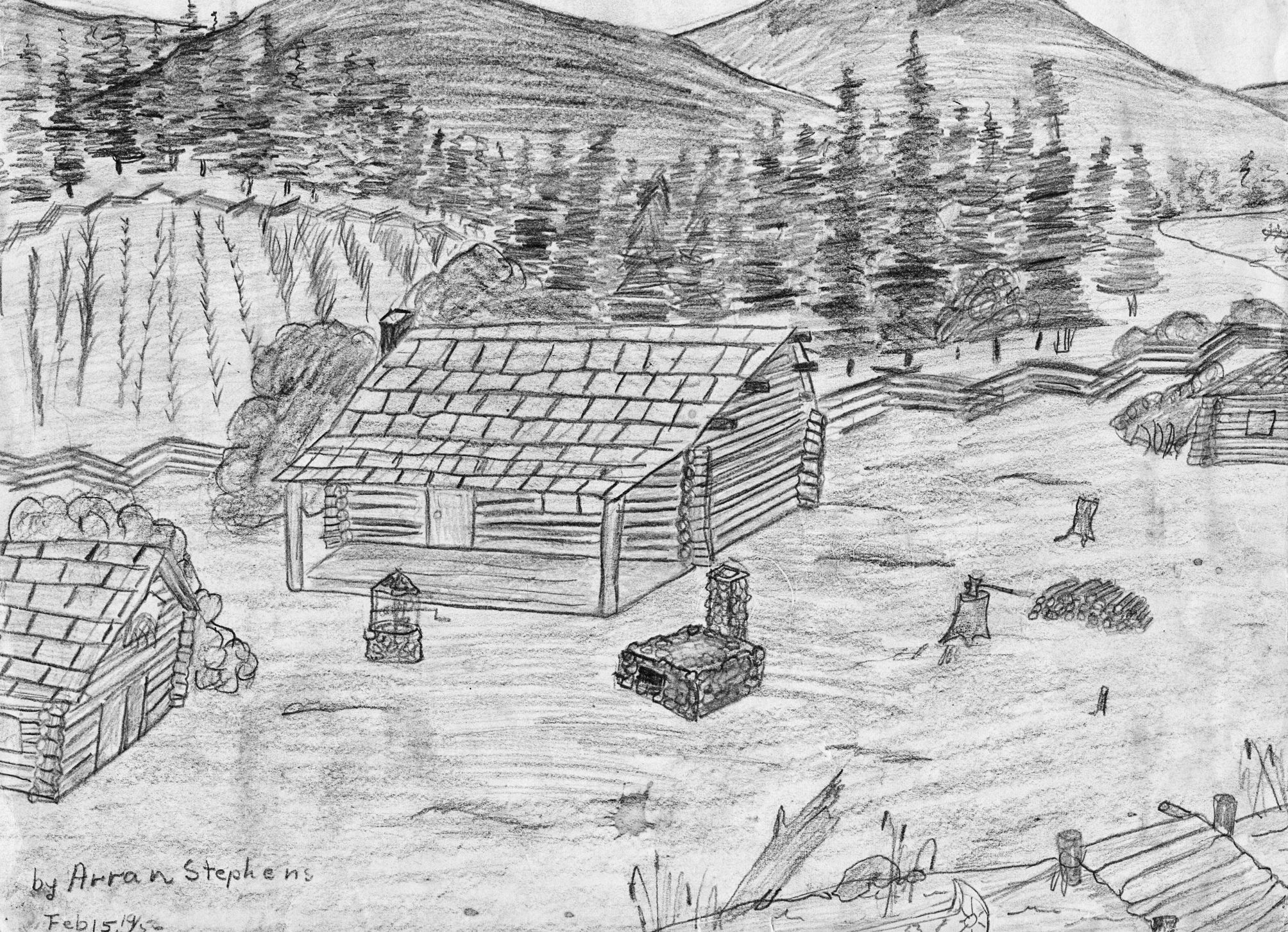
1956. Graphite on Paper. 9” x 12”
The themes of nature and wilderness showed up early in his life, growing up on Goldstream Berry Paradise Farm on Vancouver Island, Canada. When he and his older brother Godfrey used to play Cowboys and Indians, Arran always wanted to be the untamed Indian (First Nations). Godfrey studied carving under the famed Kwakwak’wa Chief, Mungo Martin. At 13, the farm was sold with considerable regret and the entire family moved to Los Angeles (Venice and Hollywood), California where his dad pursued his next career at age 60 to seek fame and fortune as a full-time songwriter, with the hopes that one day he would return to Goldstream and buy back the farm for his kids. That dream, however, was not fulfilled

1959. Oil Painting 12'“ x 16”
Arran’s first oil painting at 15 done in Hollywood, CA, displayed a unique invitation to enter into the blue forest’s depths.
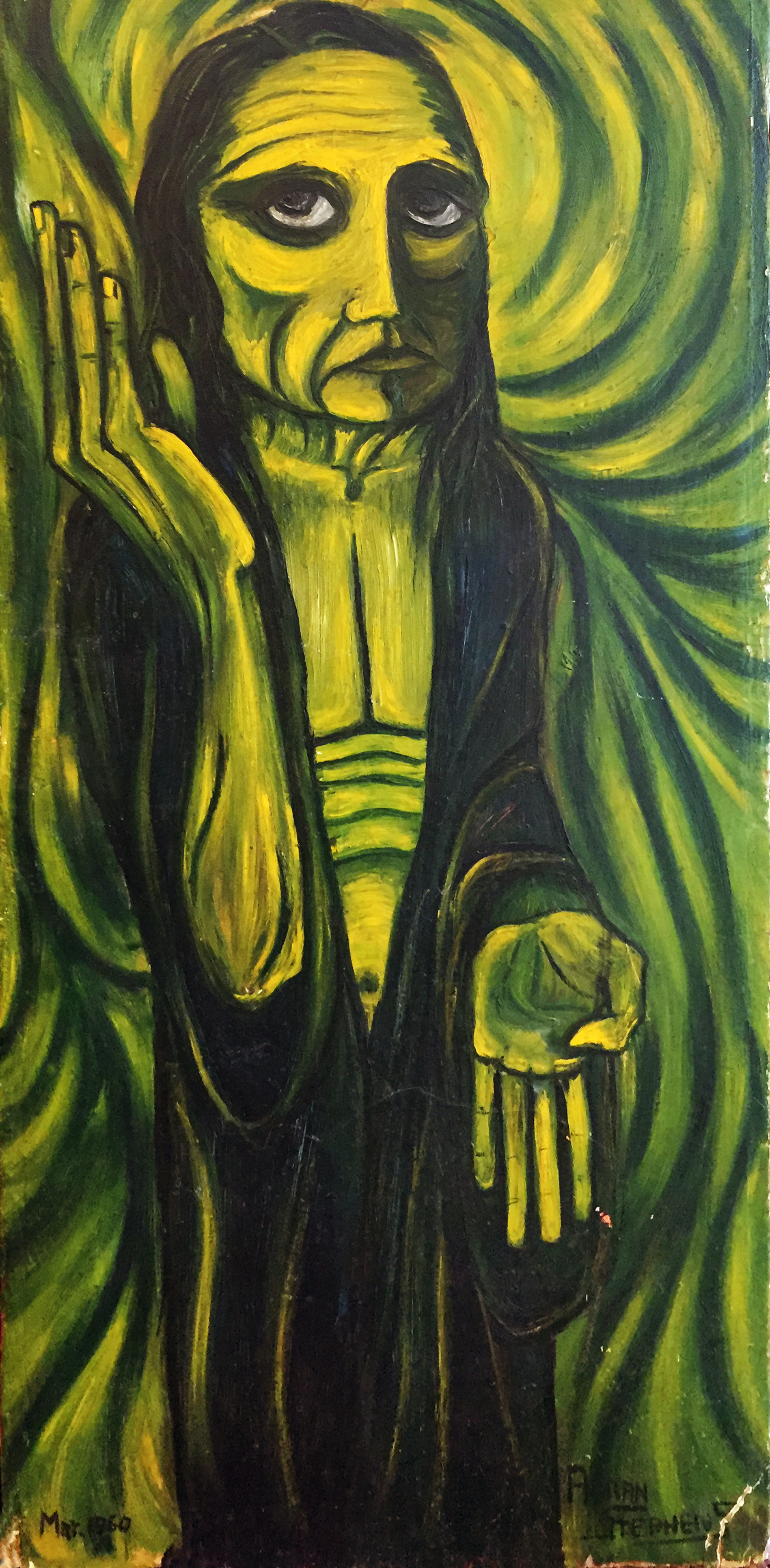
1959. Oil on masonite. 16” x 36”
In his second-only oil painting, created in his cheap studio above Hollywood’s Music Box live theatre, Arran imagines a prophet-like being as he experiments with this painting medium. Other than his father, Rupert, the first actual wise man that he met and befriended was in 1961: Eden Ahbez, vegetarian, activist and author of the beautiful song, Nature Boy, made famous by Nat King Cole.
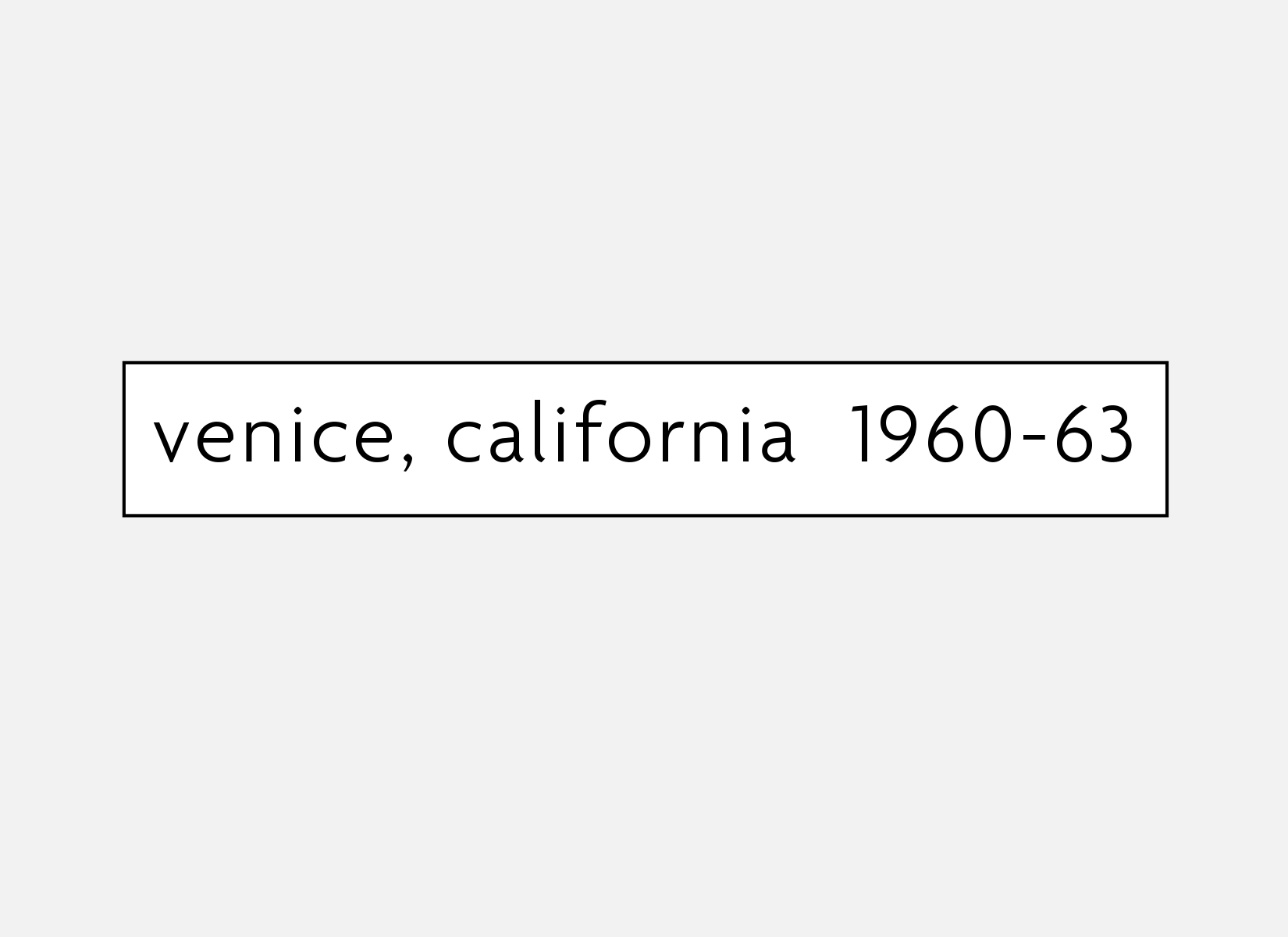
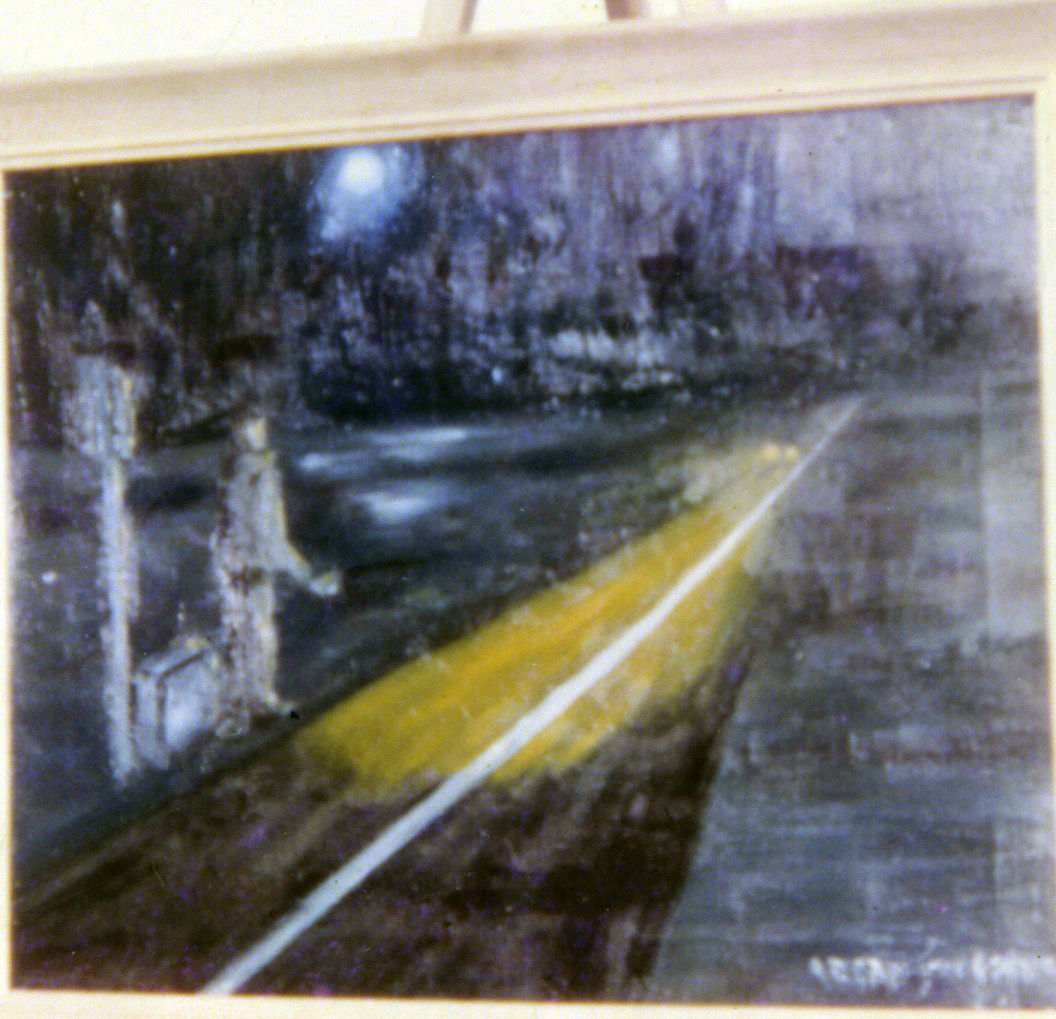
1960. Oil on masonite. 14” x 18”
His third oil painting. The road forward proved to be both a difficult but enlightening journey for the young artist, now living in Venice, CA. This poor photo is the only copy of this primitive painting. Inspired by Jack Kerouac’s book, “On the Road.”

1960. Oil on masonite. 18” x 24”
Angst and uncertainly in Venice. It was a time of possible anihliation by global nuclear war as the US and Russia were going at it hammer and tong; a troubling time for a deeply troubled teenager in search of the meaning of life. This overexposed photo is the only thing left of Arran’s third oil painting that depicts the last man on Earth in the aftermath of nuclear armaggedon. Arran begins to slip into a murky world.
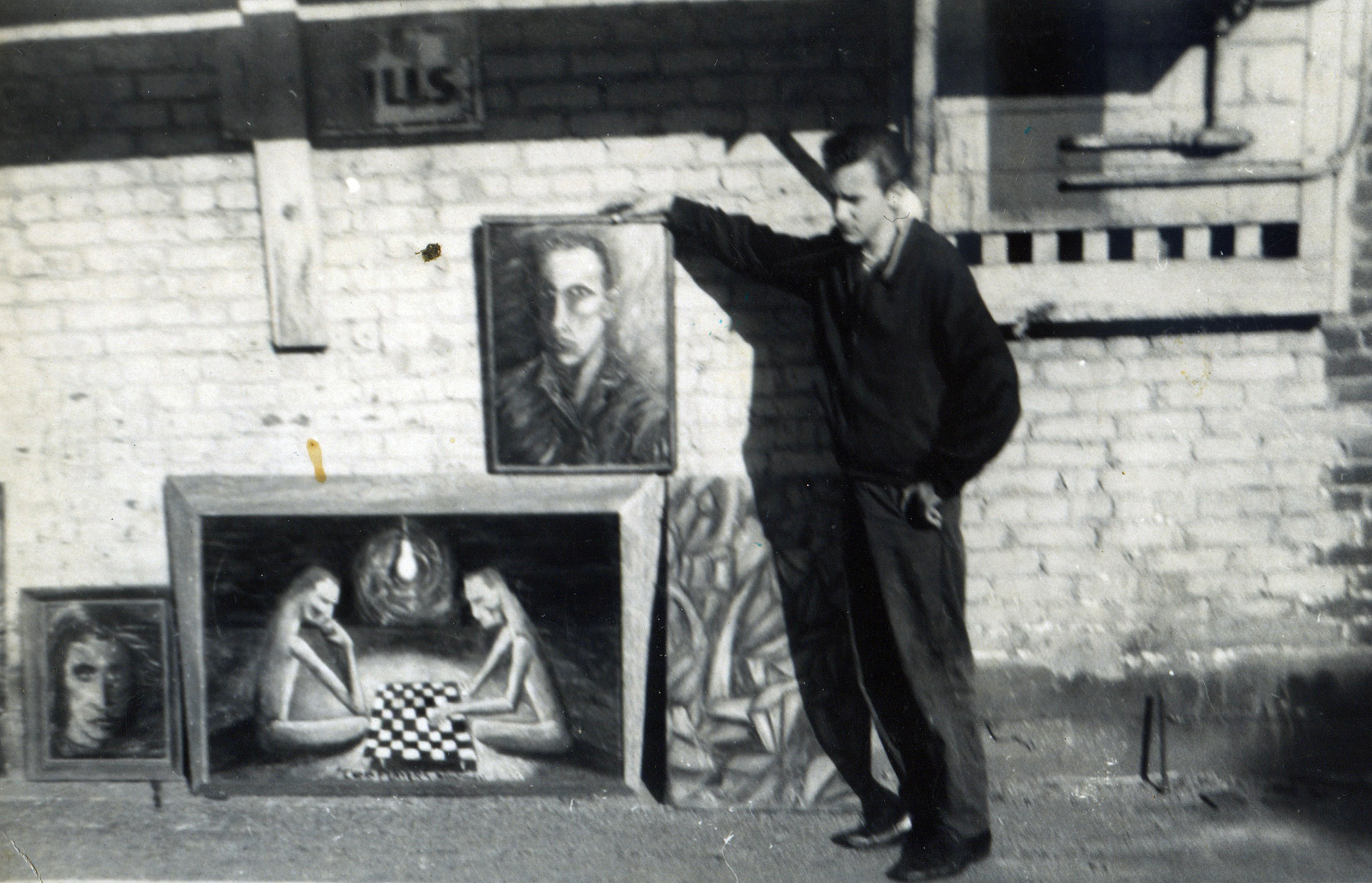
1960. Oil Paintings.
At sixteen years in heart of the Beat Generation’s milieu, Arran sometimes slept in a cardboard box on Venice beach, sometimes foraged for food in a dumpster; it was a time of angst, exploration and depression. Considering the lives of great artists and poets, he thought perhaps the way to greatness was through suffering. Only much later would he discover that suffering and happiness do not come from without, but from within
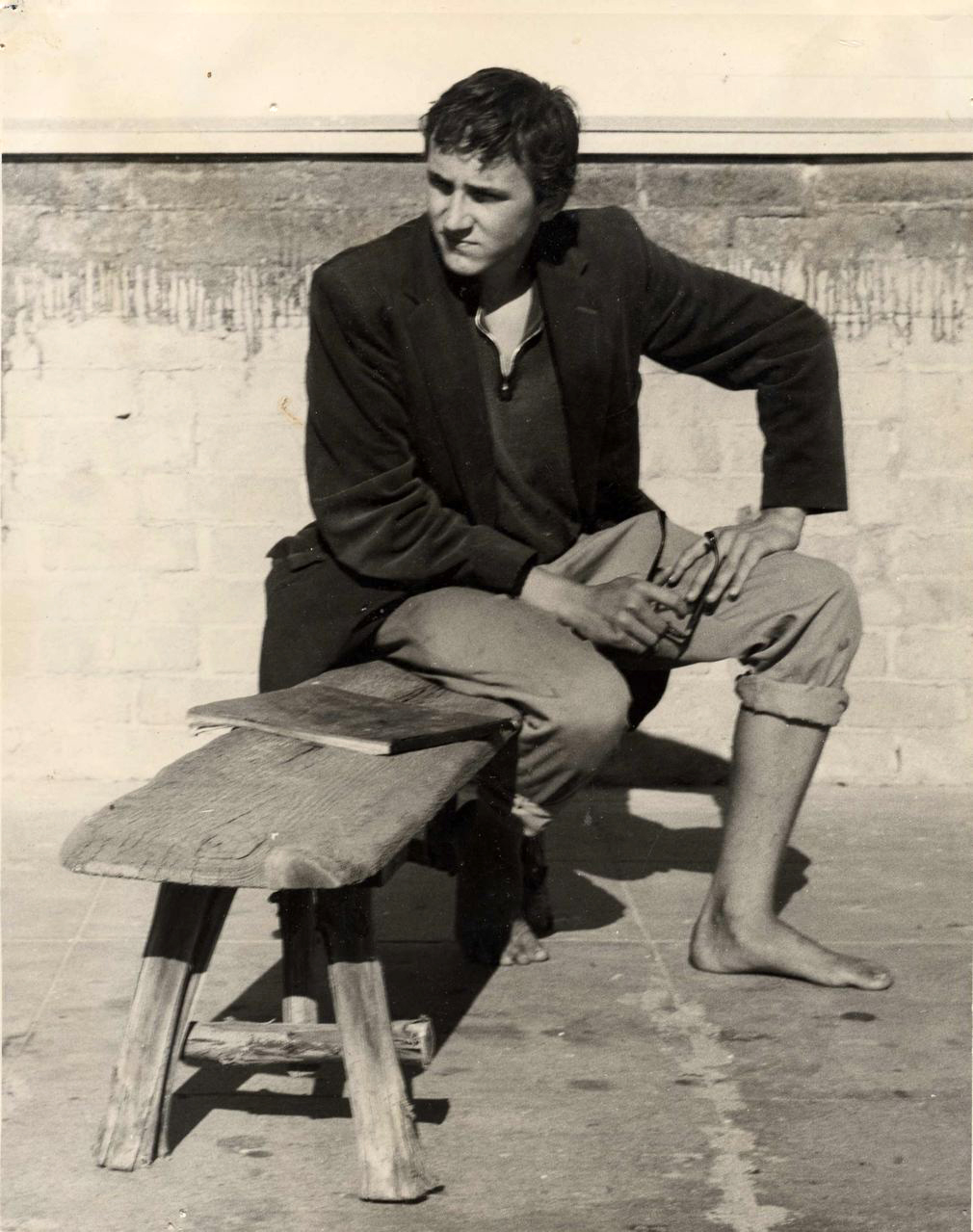
A very existential look, searching for life’s meaning at seventeen—certainly reflecting troubled times.
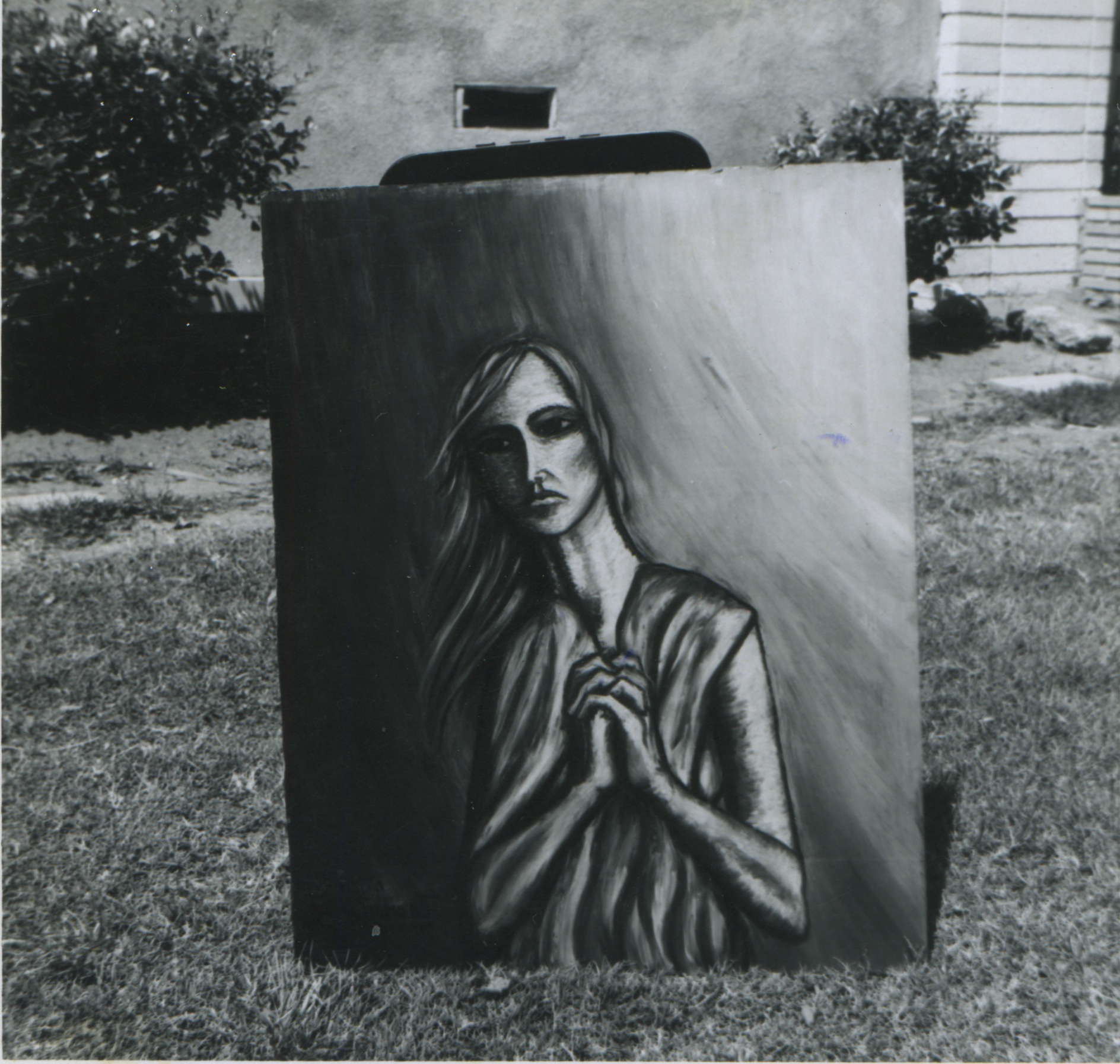
1960. Oil Painting on masonite. 24” x 32”
An early portrait of prayer and longing—a theme that continues to develop over the years.
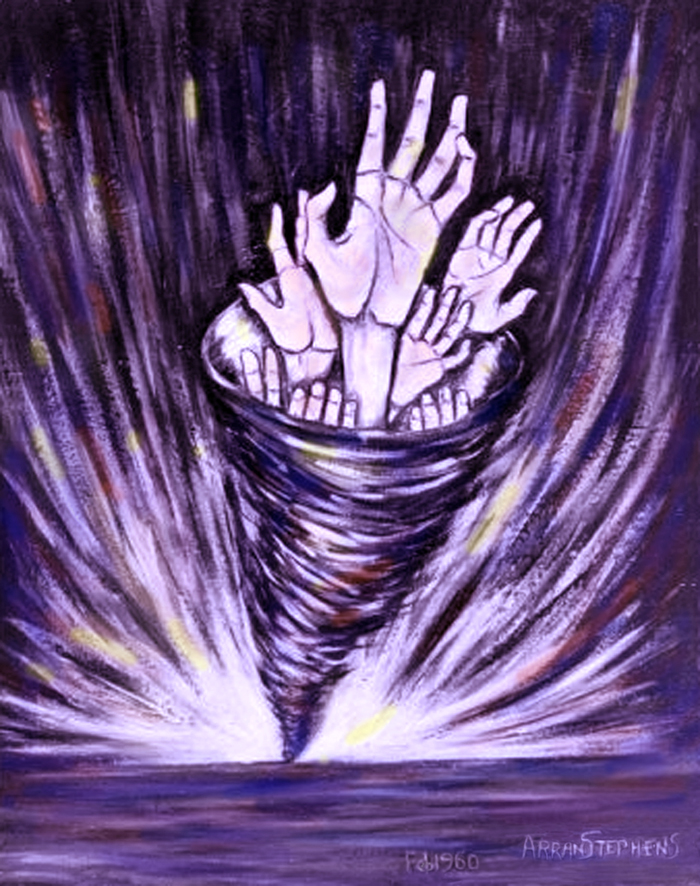
1960. Oil Painting on masonite. 36” x 48”
There was something inside, yearning to be let out and set free. A tornado of inquiry rose up from the depths of emotional seas. Arran went through a period of deep depression over the dissolution of his family, succumbed to substance abuse and entertained suicide. Interestingly, this painting was bought by an eminent Los Angeles psychiatrist for the princely sum of $100, which paid Arran’s rent and bought him some paint supplies.

1961. Photograph.
The artist at work on his “Venice Pier” painting.

1961. Oil Painting on masonite. 20” x 28”
Another emotional blossoming of expressionism, full of lively brushstrokes, pallet knife and graphic composition.
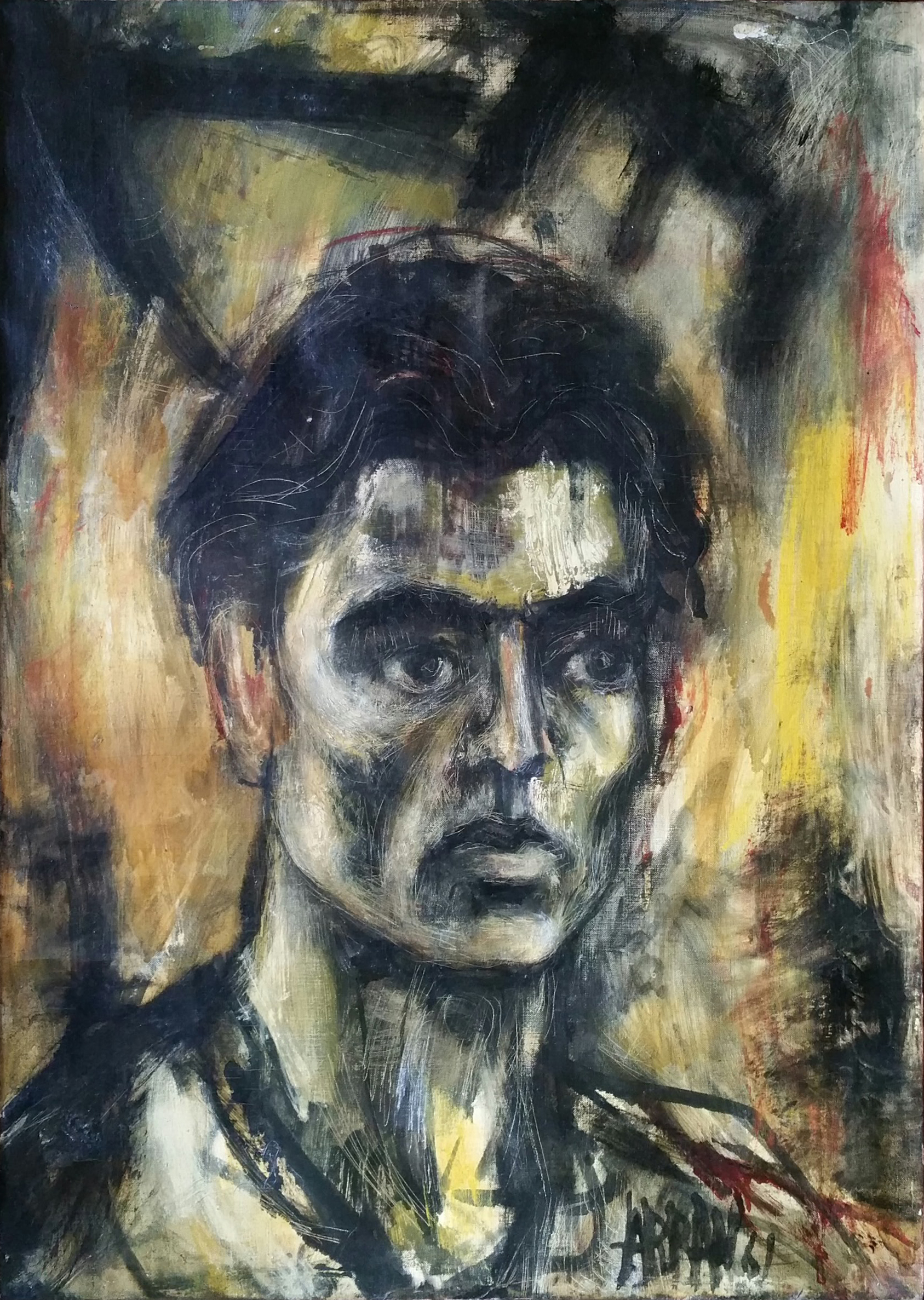
1961. Oil Painting. 24” x 36”
Arran’s portraiture of his good friend and sculptor, “Rodie” Roland March takes a dramatic turn with this expressionistic burst of emotional strength and exploratory color. According to the artist, this was his first significant portrait.
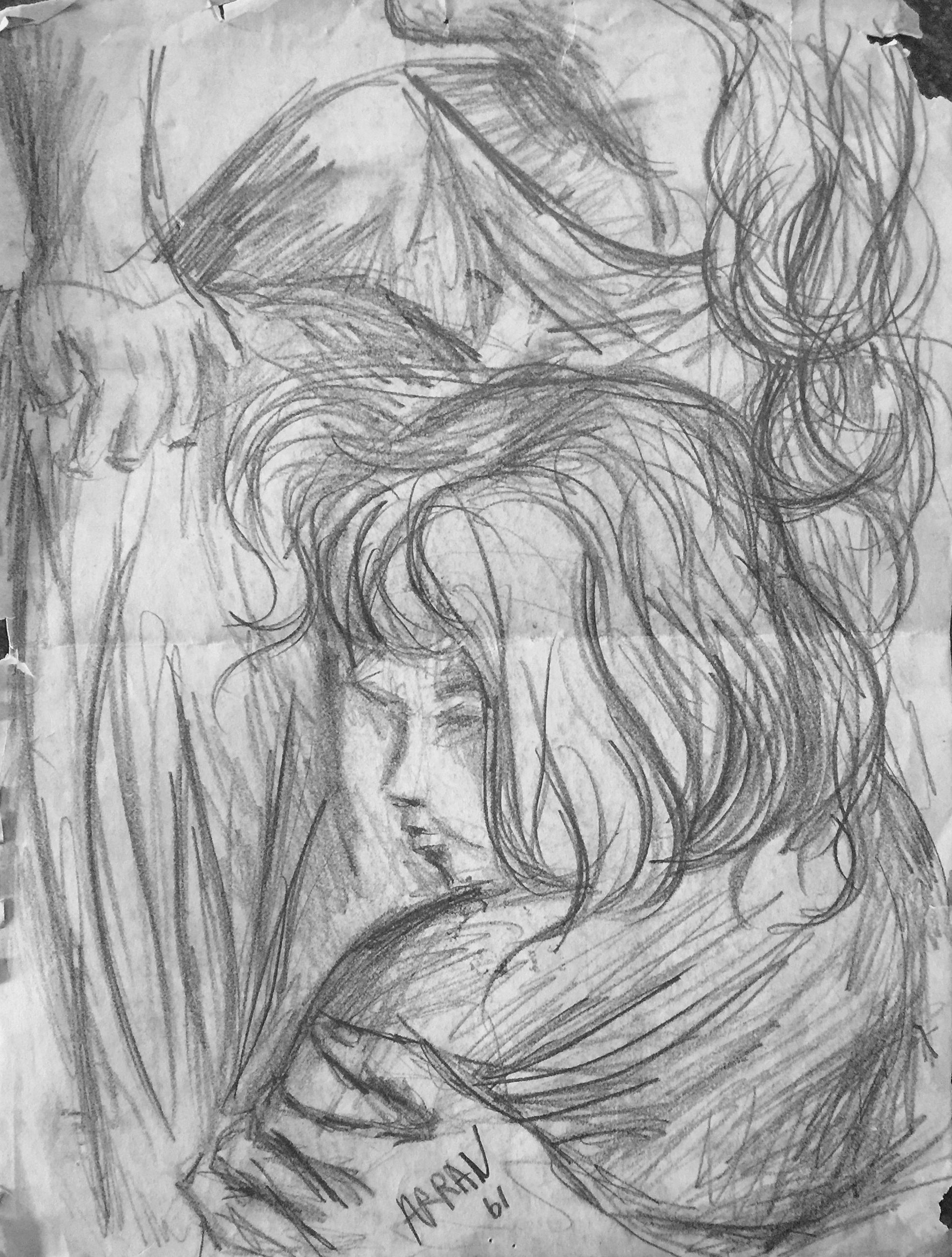
1961. Graphite on Paper. 16” x 20”
Expressionistic study of Harriet March and child Megan, graphic in composition.
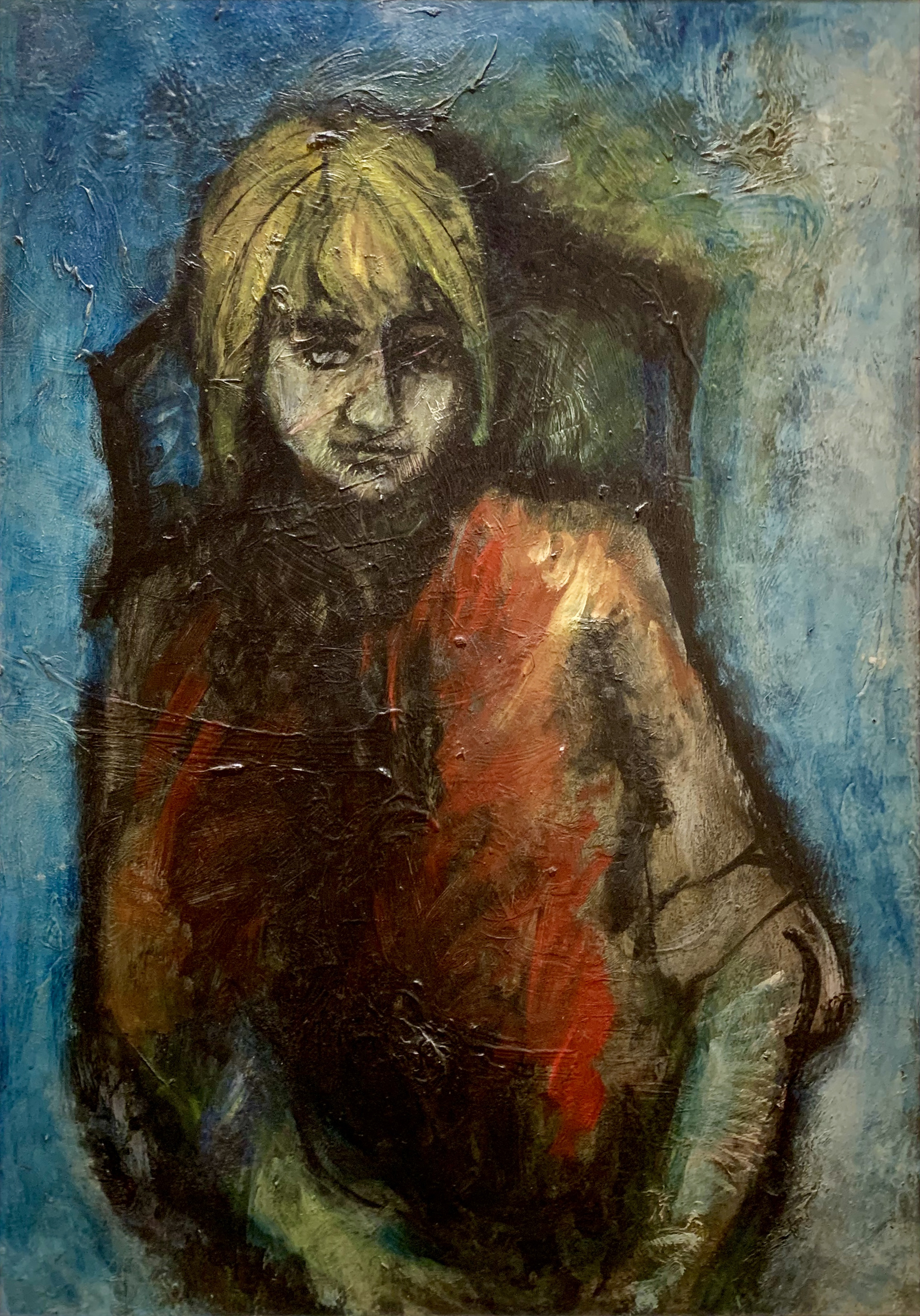
1961. Oil Painting.
Arran painted this in his Venice, CA studio.

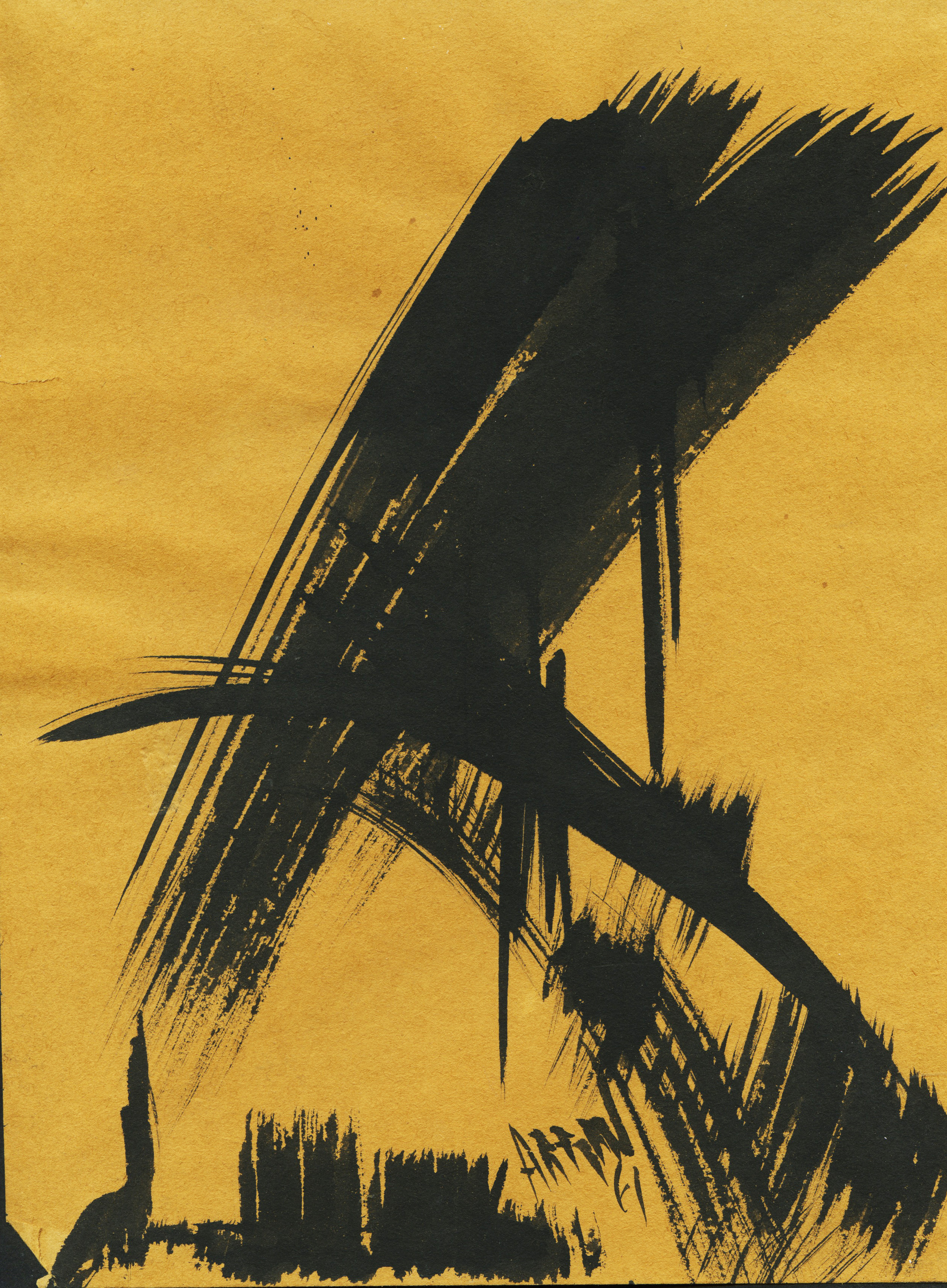
1961. India ink on Paper. 10” x 14”
Here Arran experiments with interjecting the energy of western expressionism into the traditions of austere, Zen-like Japanese design.

Oil on canvas, 1962, Vancouver.
This was painted in Vancouver, winter of 1962 at age 18. My unheated 4th floor studio apartment was in a rickety old wooden tenement building on Drake Street, so cold that the water froze in the sink and the toilet didn’t work. The painting reflects the times, it’s dark and moody. This was a difficult period of self discovery. From Vancouver, I hitchhiked down to San Francisco’s North Beach, had many unusual adventures, and landed in the thriving Beat/Art Scene where I lived and painted for the next two years, with a few more months in the wild Venice Beach Beat scene. During this time, I met Lawrence Ferlinghetti of City Lights Books, Allen Ginsberg, Eden Ahbez of Nature Boy fame, and many other unique poets, jazz musicians and artists. It’s a wonder I survived!
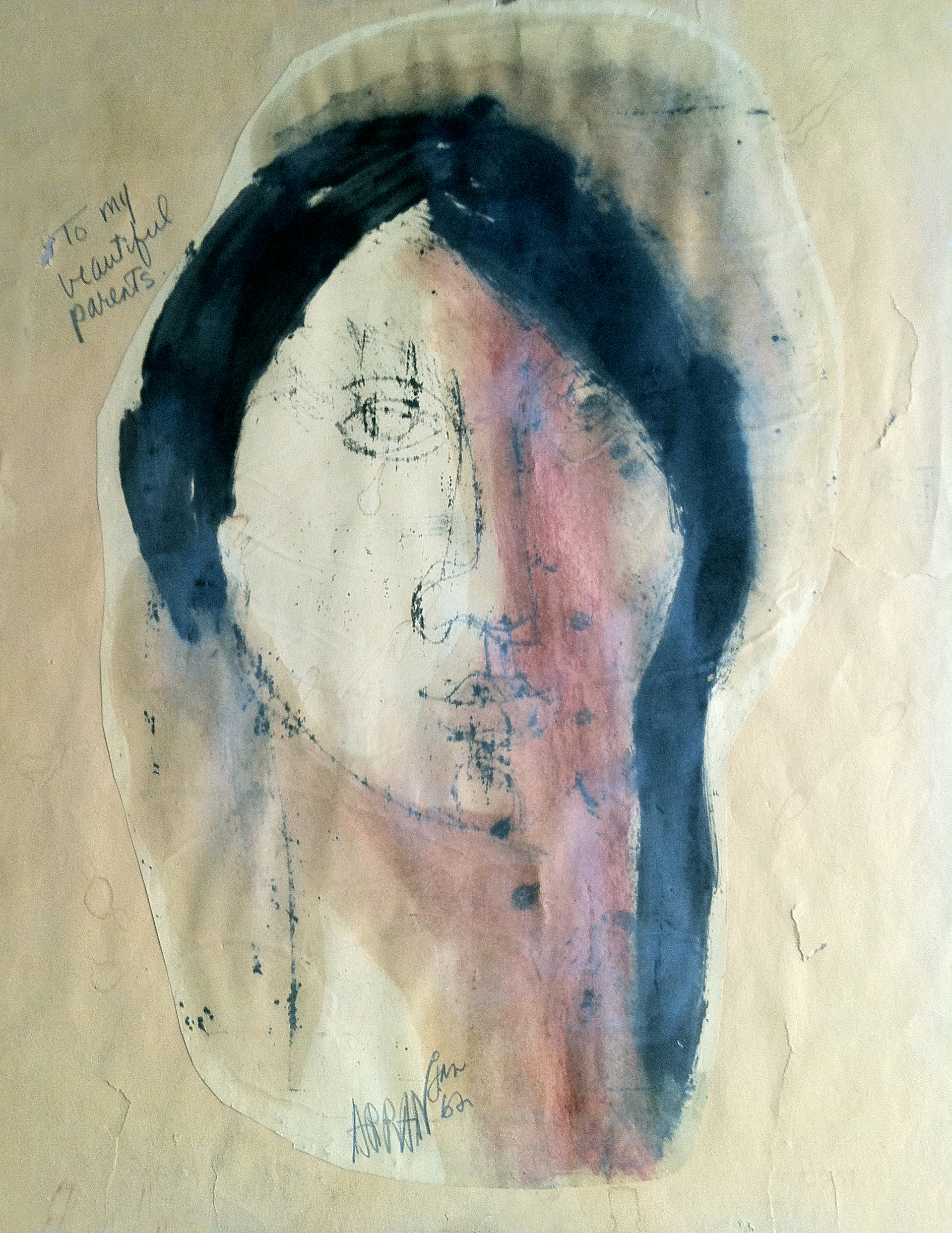
1962. Dry Media & Watercolor. 12” x 16”
More explorations into modernism, during a year’s stay in Vancouver. The dark frame of the hair draws the eye down through the colored washes layering the under-drawing of the face.
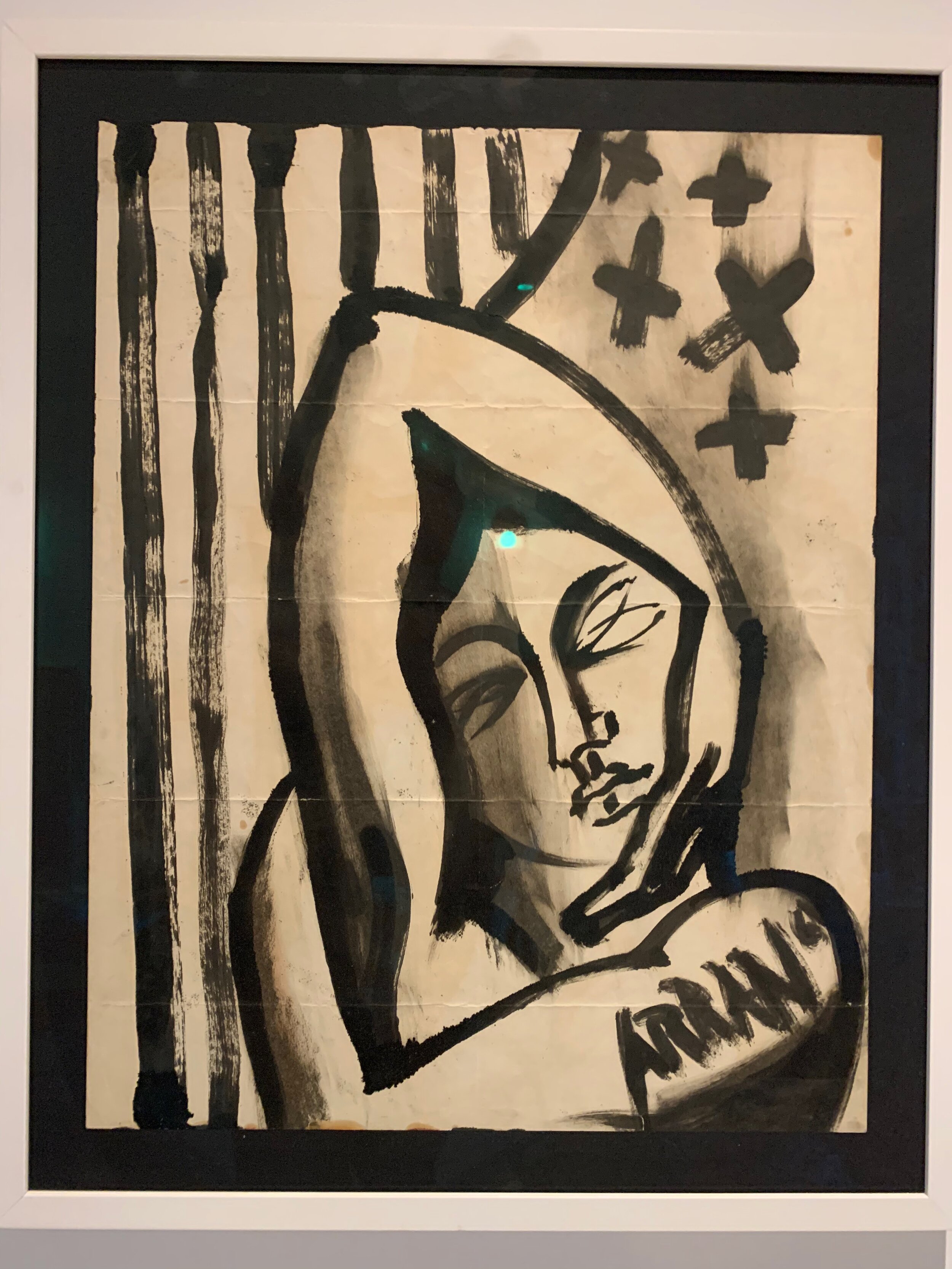
Black paint on paper
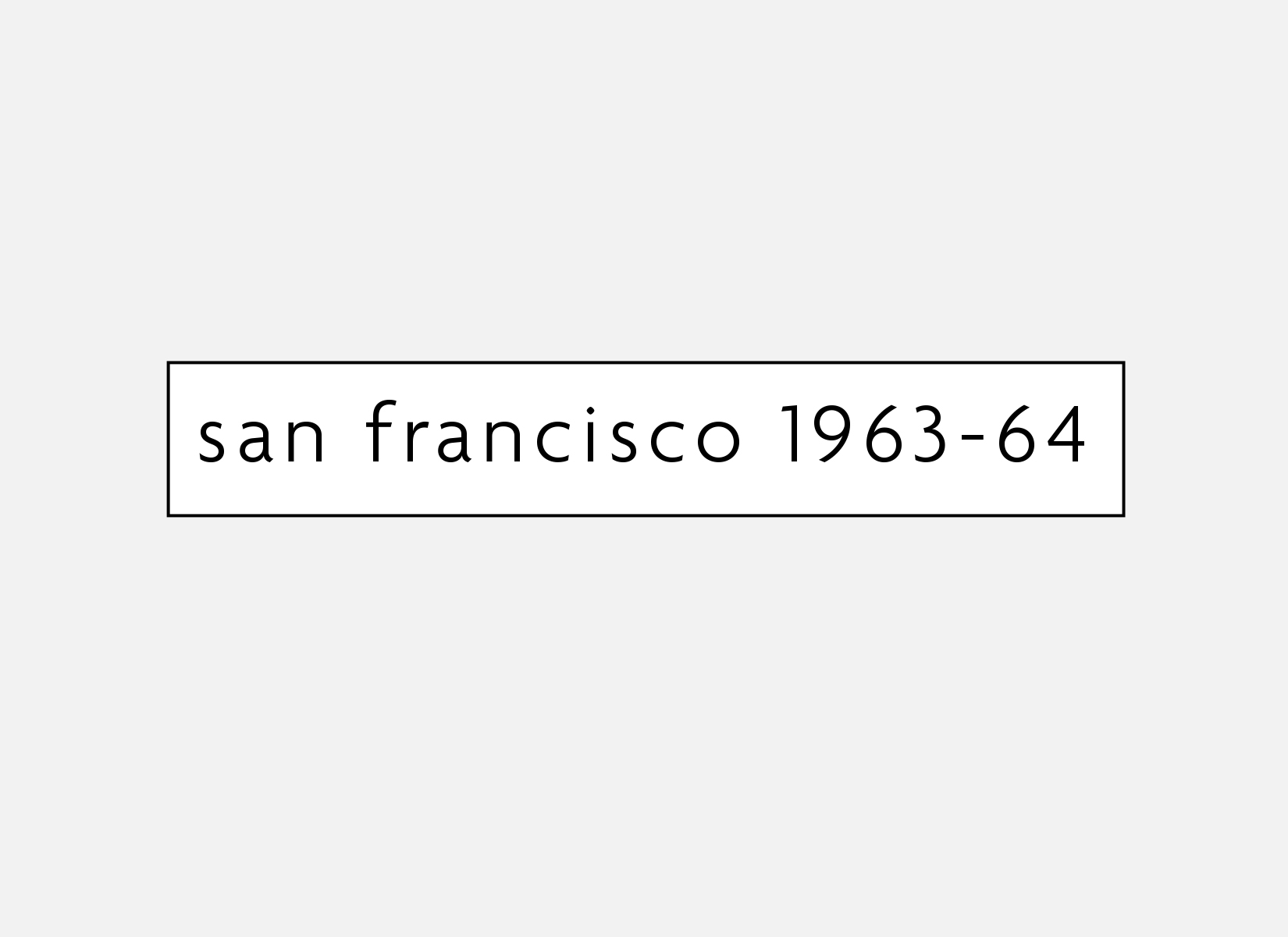
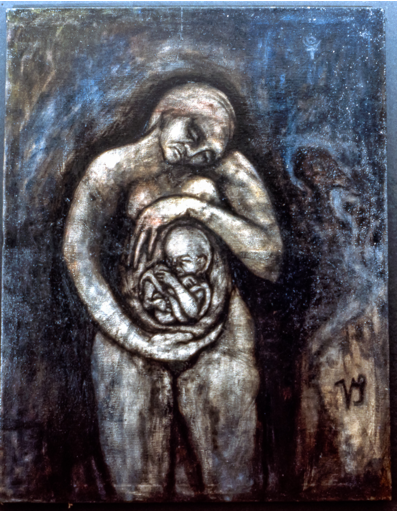
1963. Oil painting. 36” x 48”
The seed of life in human form. The mother and embryo are as though carved from granite. Only in later years when the artist established his own family did his works reflect more light, life, warmth and color.

1963. Pen & India Ink. 10” x 14”
While sitting in a cafe in North Beach, watching passersby, the artist sketched this sensitive portrayal of a brother on the street, thinking, “There, but by the grace of God go I.”
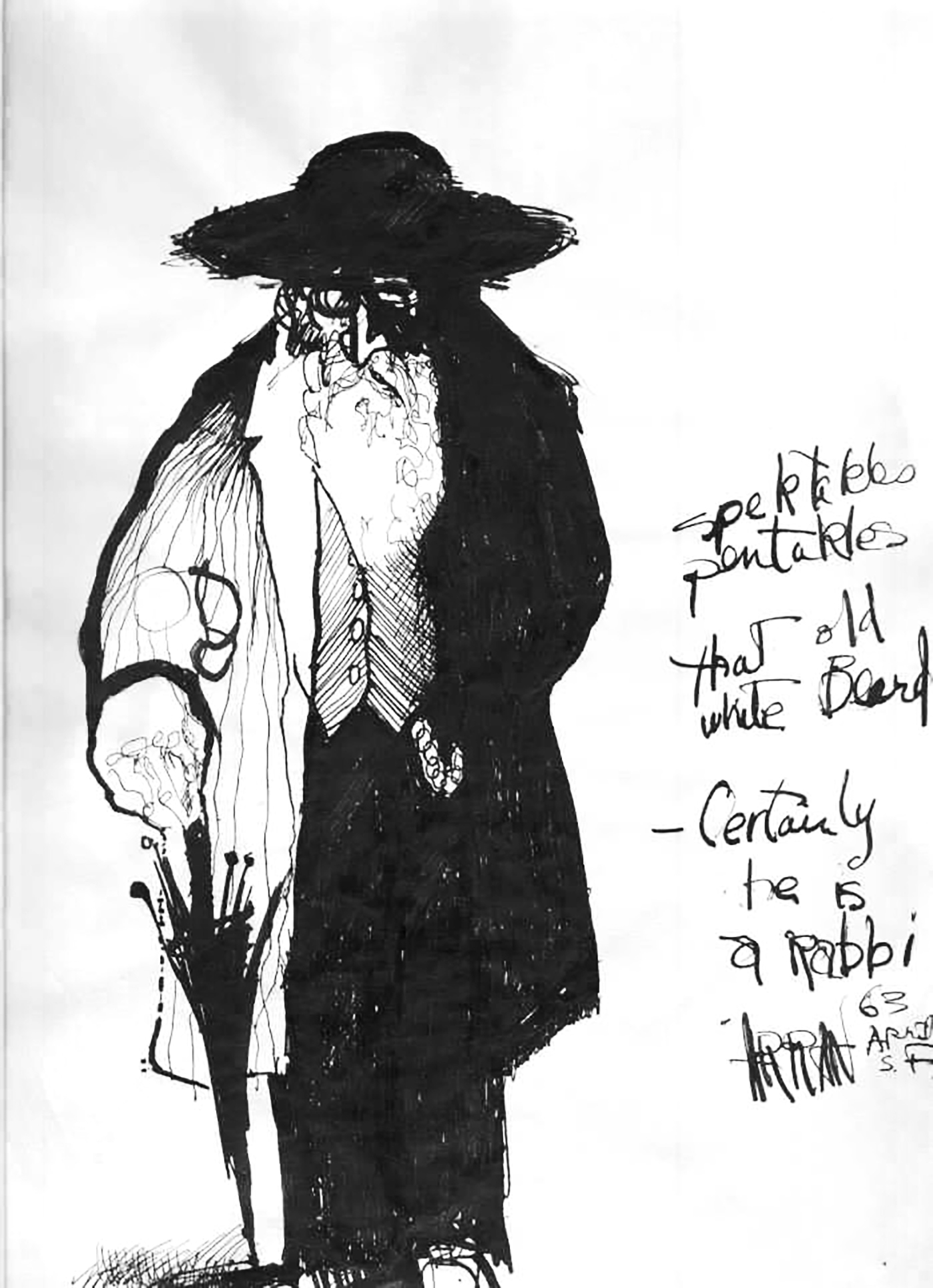
1963. Ink on Paper. 10” x 14”
Sketch for the painting of The Heirophant, displayed at San Francisco’s iconic Batman Gallery later that year. Inspired by the dramatic sight of an old Hasidic Rabbi walking along the Venice Beach boardwalk.
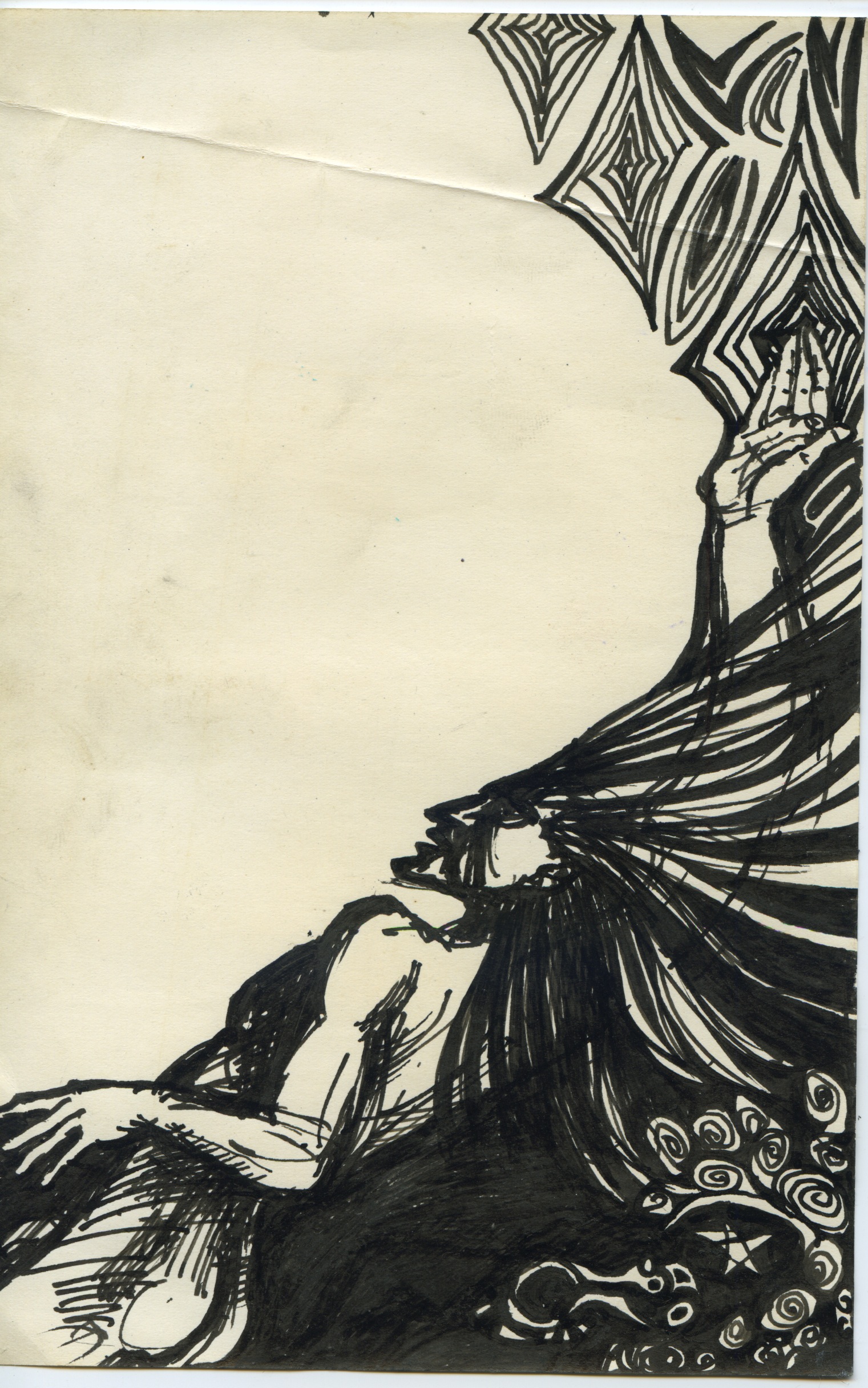
1963. Ink on Paper. 12” x 14”
Doodle drawing
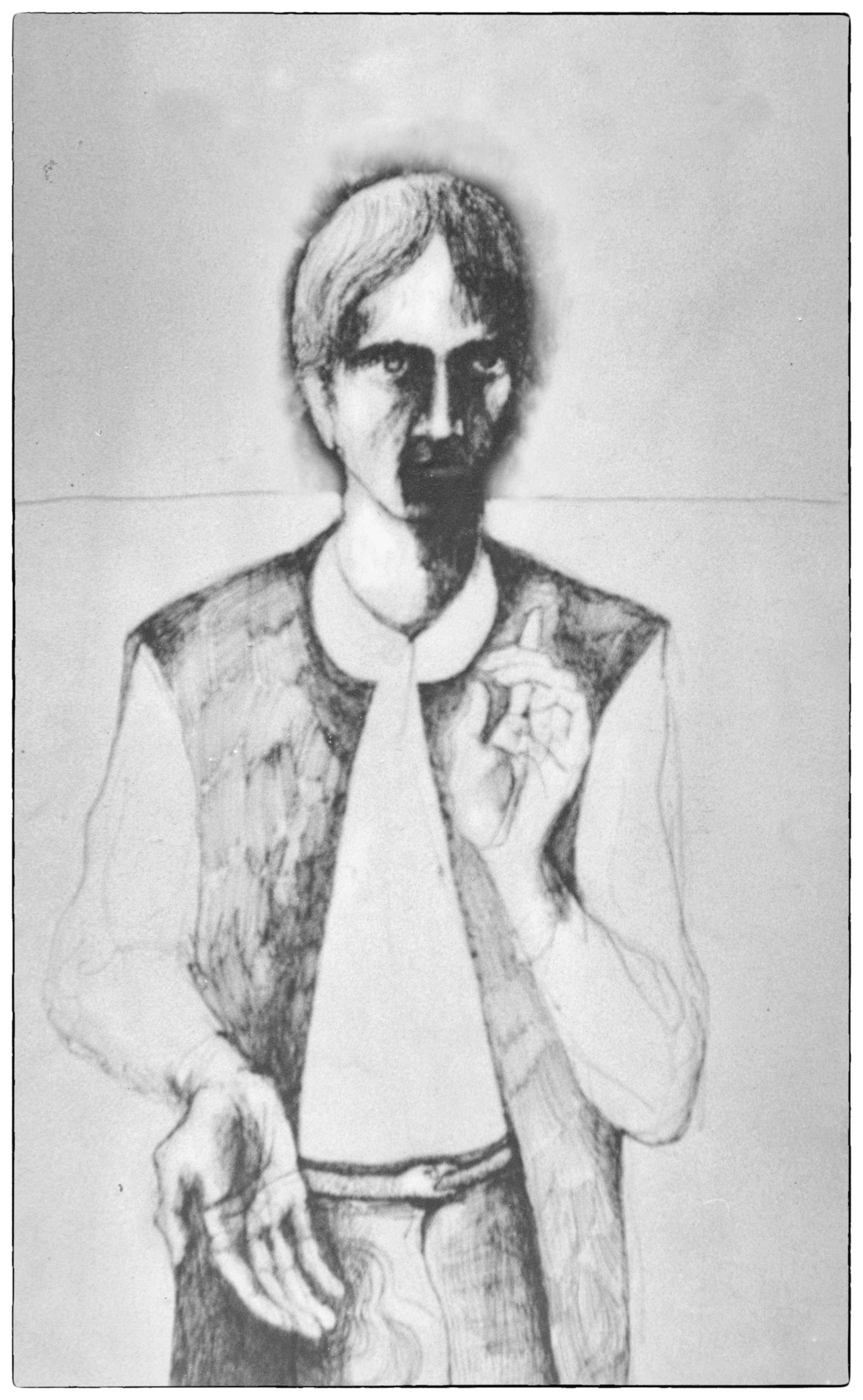
1963. Ink on paper. 12” x 14”
An exploration of a portrait form.
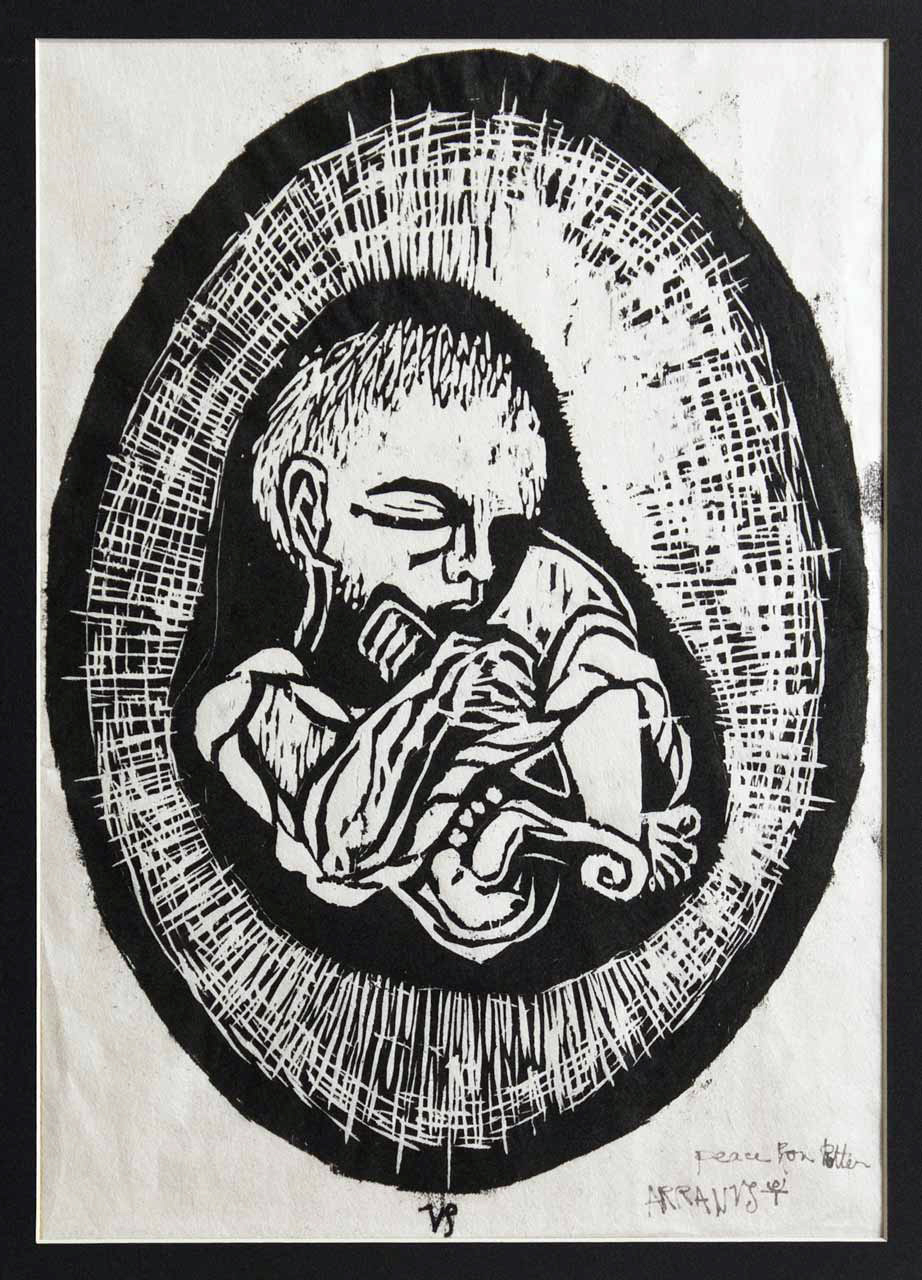
1963. Lino Print.
Expressionistic imagery of our primal human condition.

1963. Oil Painting on linen. 48” x 60”
Arran first saw an old Rabbi walking down the Venice Boardwalk in 1961, and the image stayed with him, and he decided that in his mind’s eye, the Rabbi represented the Hierophant and decided to paint him in 1963 from memory. In the vocabulary of the Tarot, the Hierophant stands for tradition, convention and counsellor who will help in the education of the seeker.
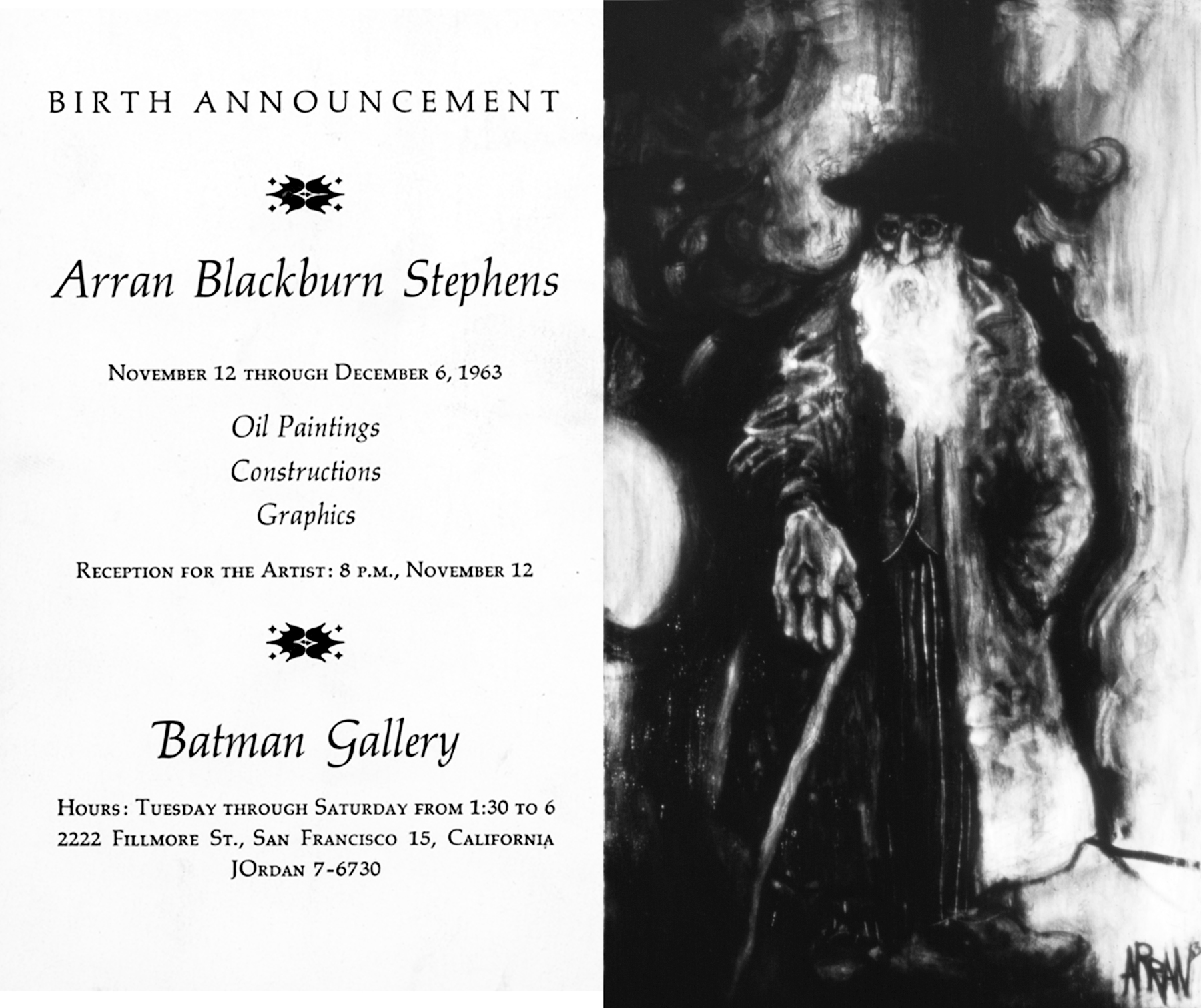
1963. Poster.
Art opening announcement for Arran’s one-man show at the influential Batman Gallery in San Francisco. Featuring Arran’s painting: “Hierophant.”
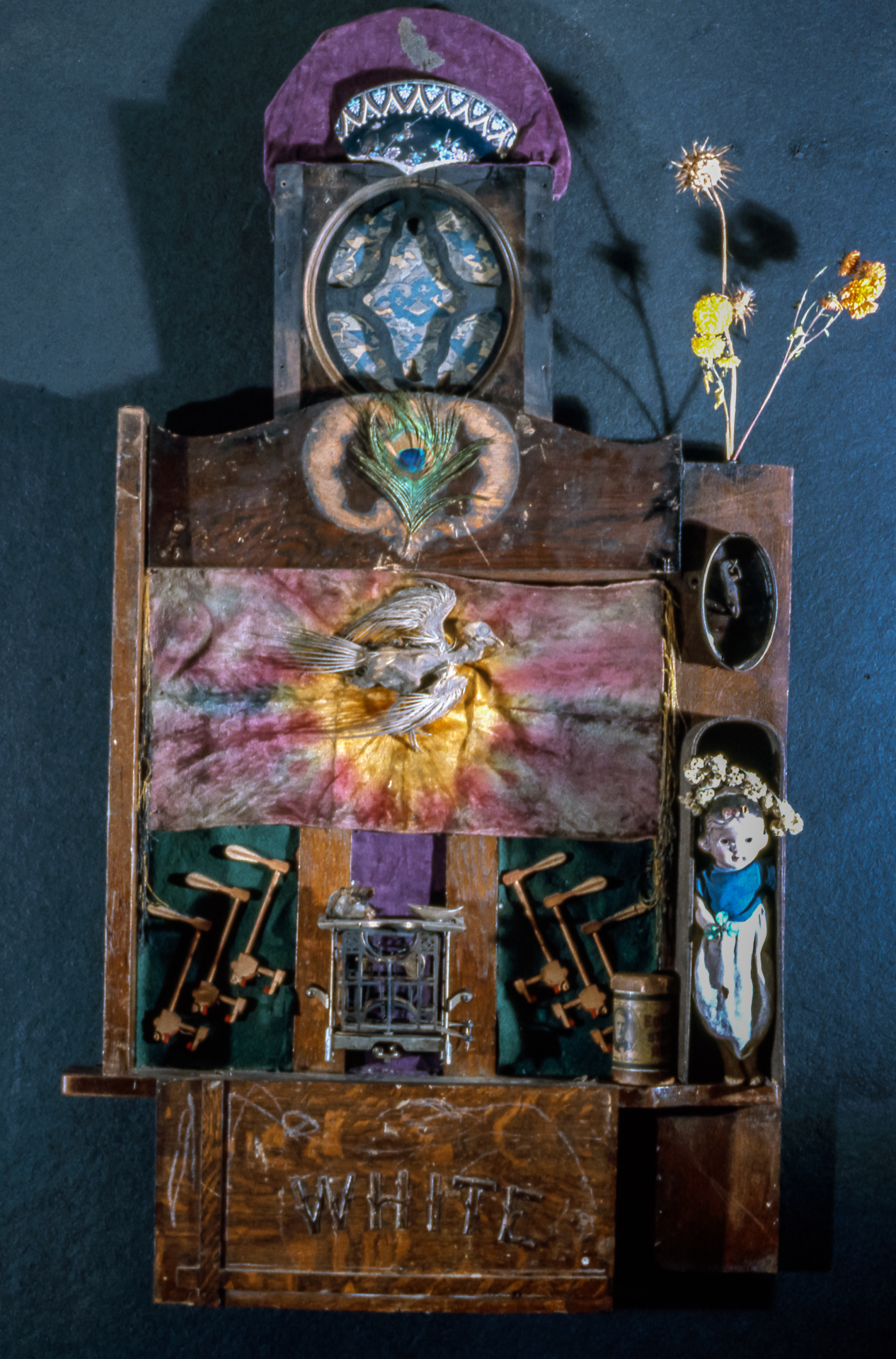
1963. Art Construction. 24” x 48”
Arran’s experimentation with the collage/construction form using found-pieces, first developed by Georges Braque in the early 20thCentury. From an assemblage of different forms, an innovative new work emerged.
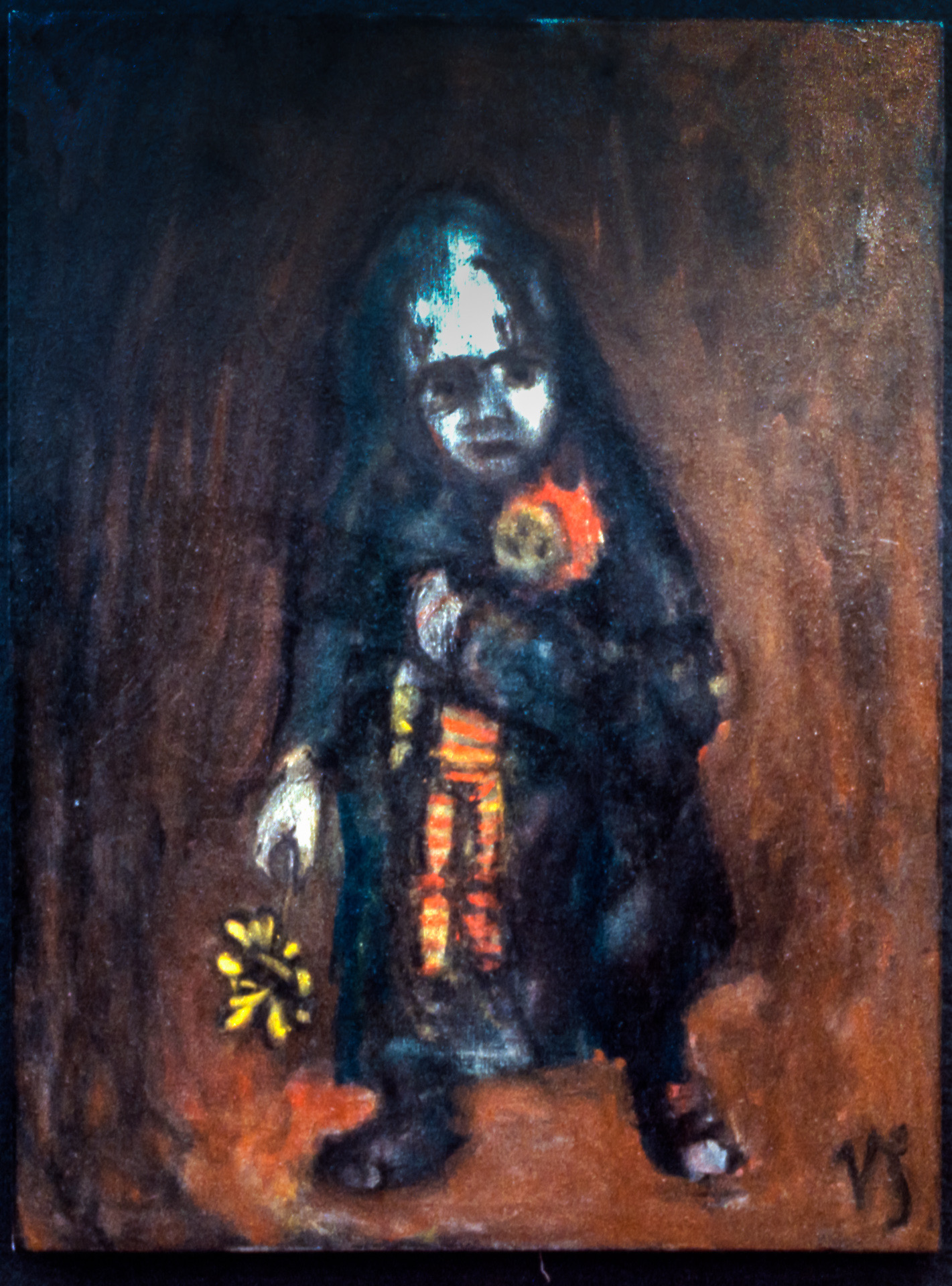
1963 Oil on Canvas 18” x 24”
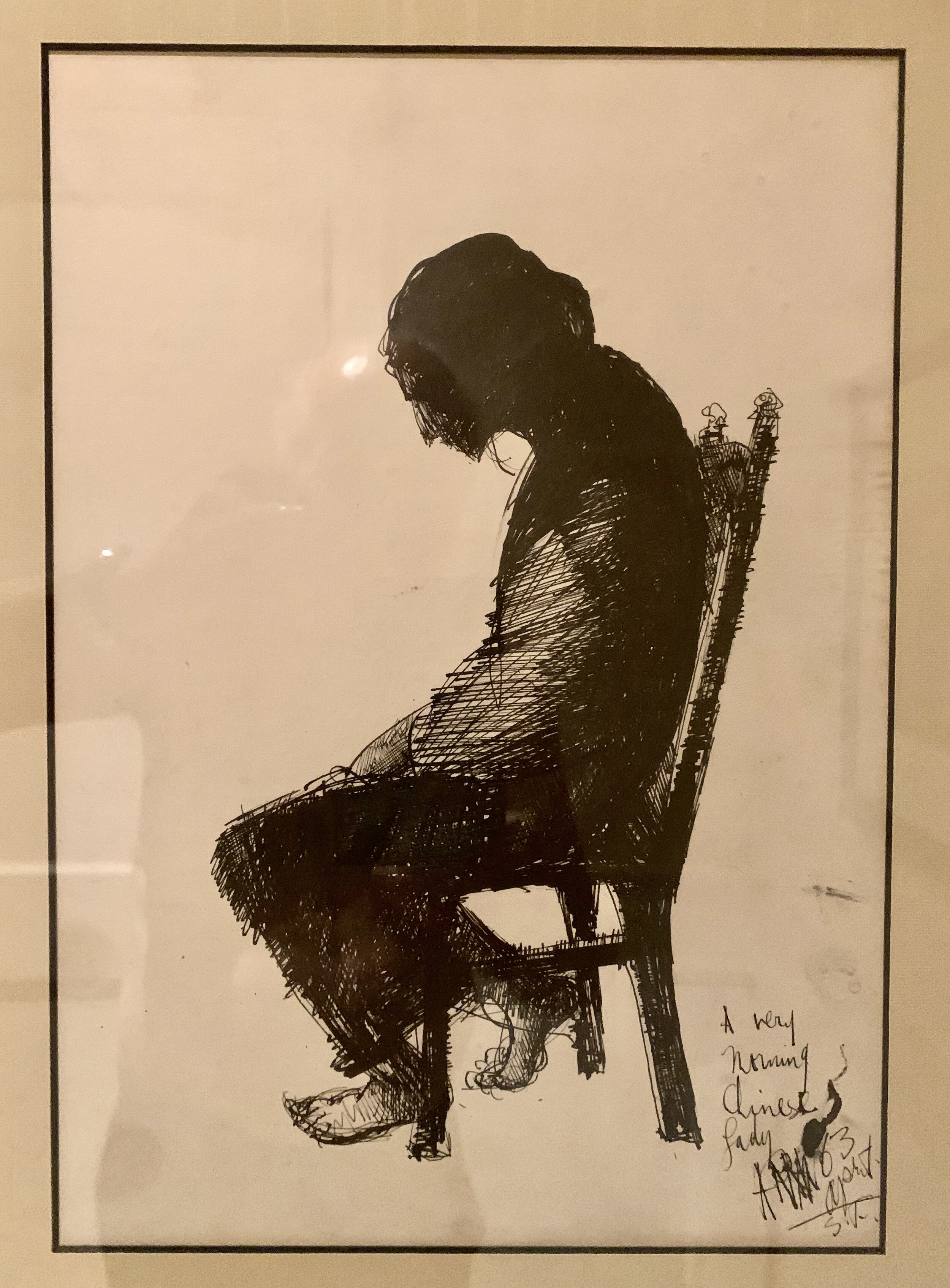
India Ink on paper sketch, 1962
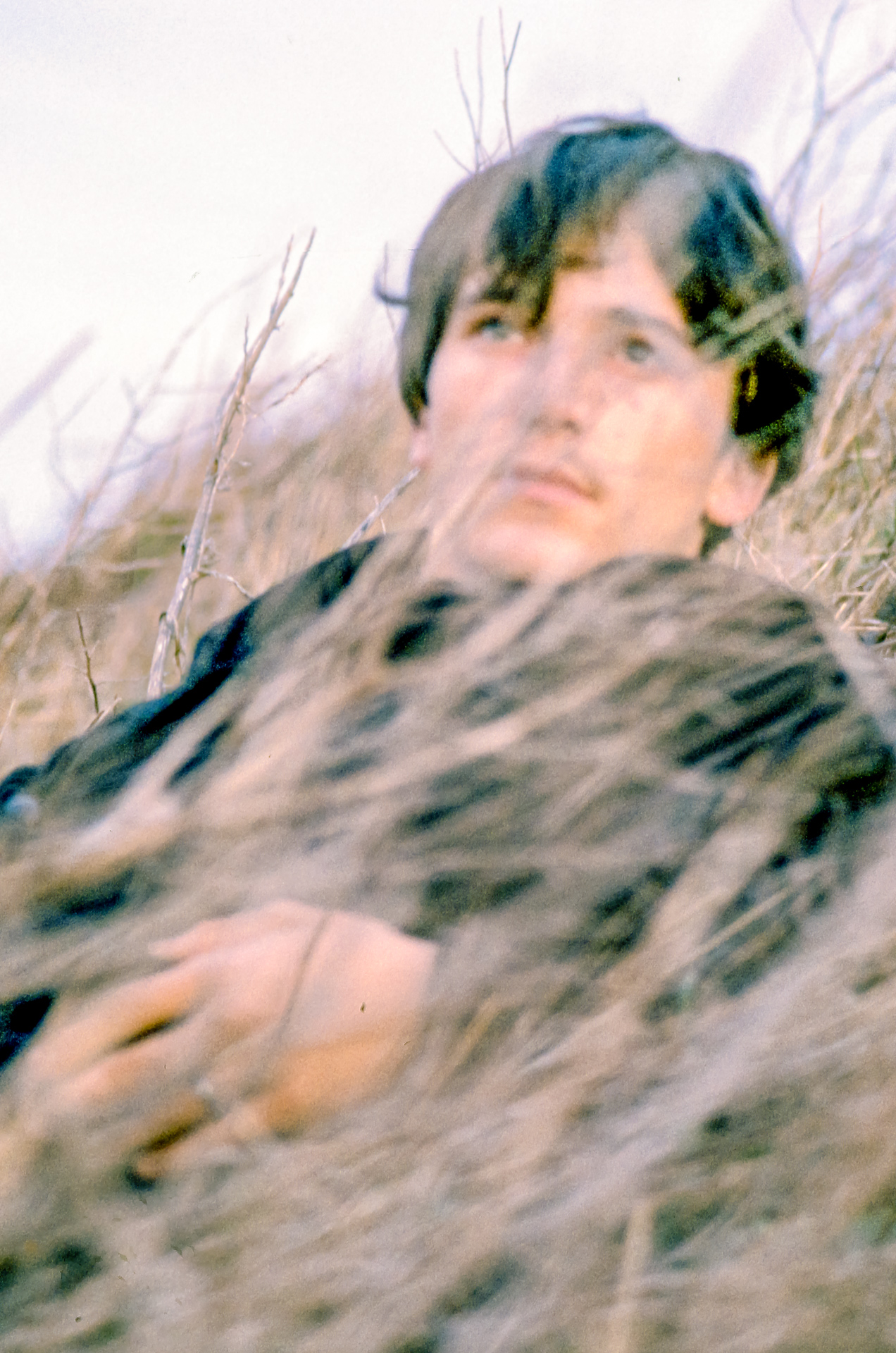
Photo of the artist at the SF mudflats, around the time of his first major exhibition at the Batman Gallery
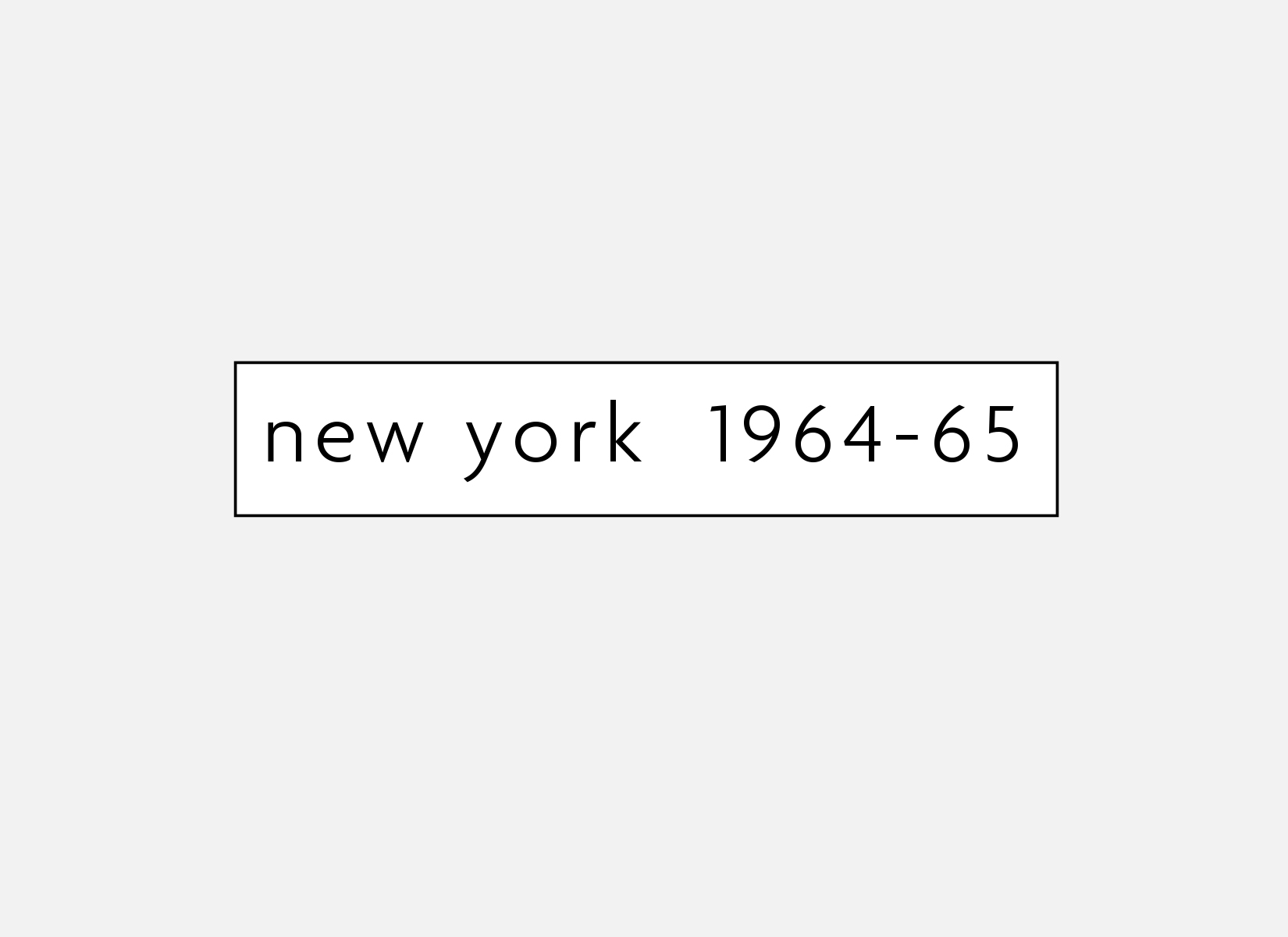

1964. Oil Painting on canvas. 48” x 60”
Within the psychedelic filled background, we can see the influence of Hieronimus Bosch at play. The vision is complex and rich with symbolism, with a masterful exploration of worlds being born with life, color and mystery. The Anubis hounds of hell snap at the wayfarer’s heels, but the street he walks upon seems to be peeling away towards the depths. Is he poised to lift off the wheel and into the gold-blue sky? Who knows? Sadly, the artist destroyed this large canvas as it evoked too many memories of the darkest period in his life.
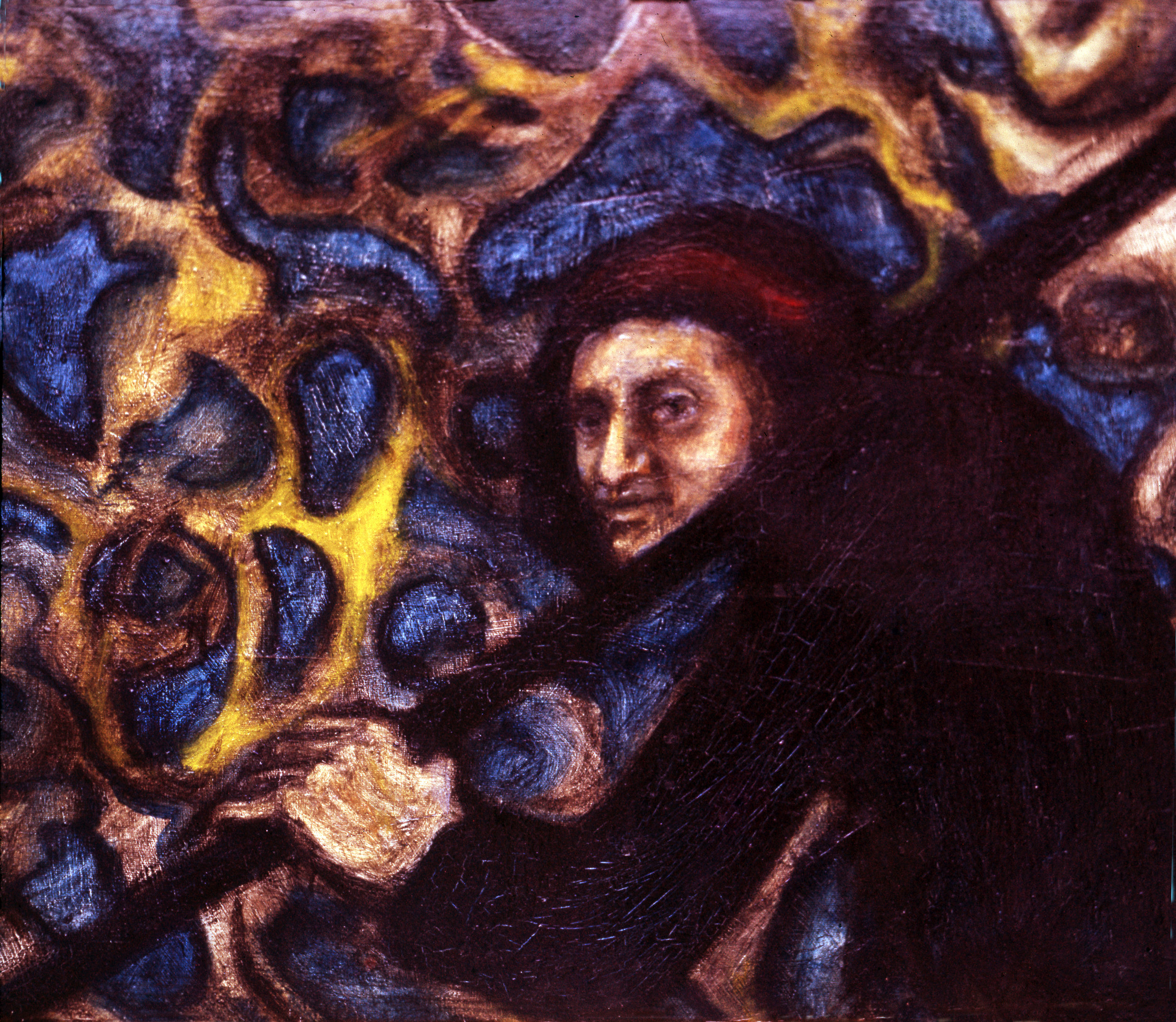
1964. Oil Painting.
Detail from Evokation.

1964. Painting on canvas.
Arran’s vison of cosmology begins to develop, partly based on his explorations into meditation and consciousness. One can see influences from both Tibetan, First Nations as well as Jewish mysticism.. in the background is the world turle (Turtle Island), how the First People’s myth of the world we live on. Hints of the Kabbalistic sephiroth and star of David are seen inside the mandala; the third eye opening in the center of the forehead, and the flowering of the light about the face indicate some awareness of the numinous essence of reality.
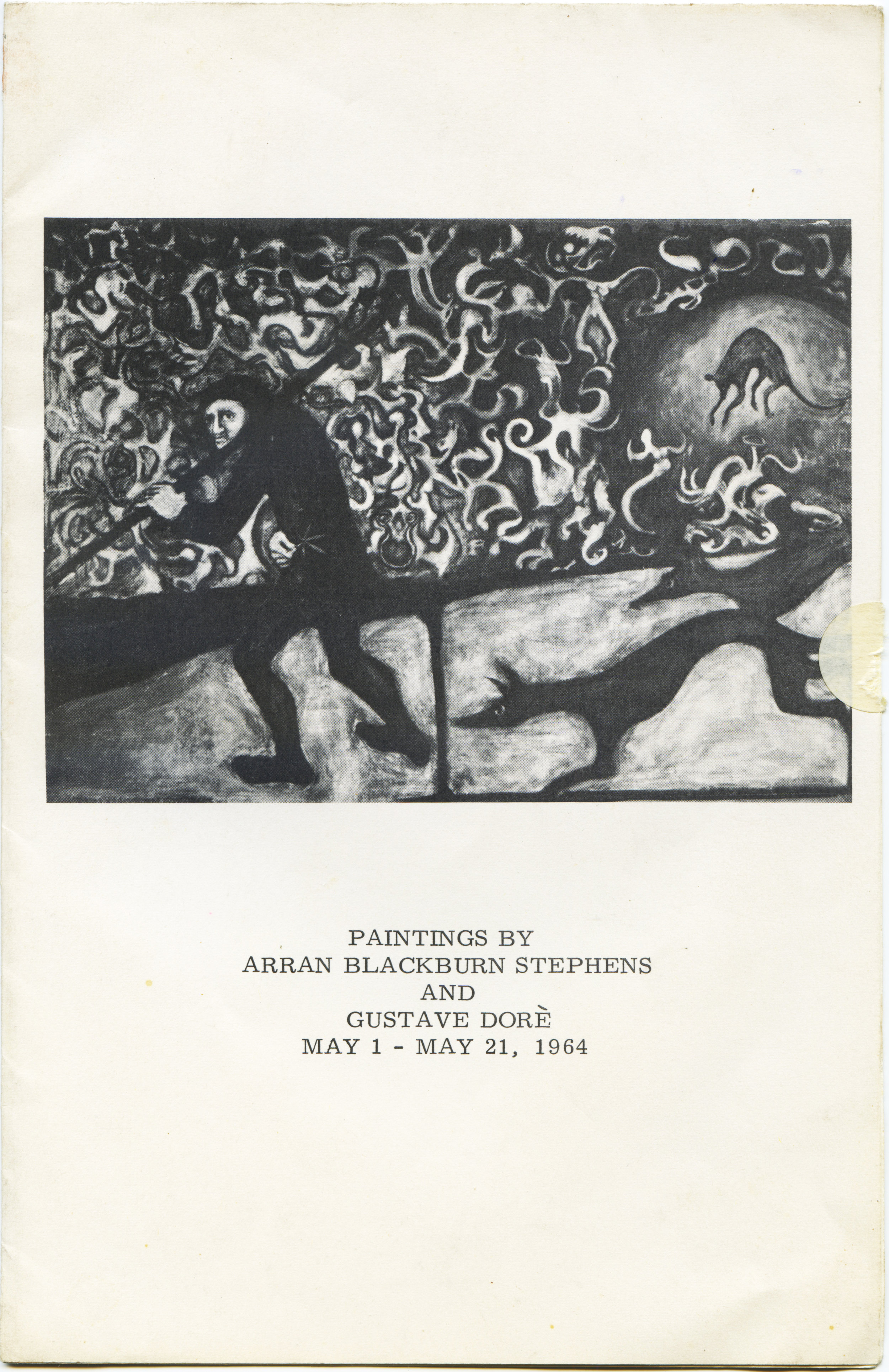
1964. LR from Brochure.
Inside image of Arran’s painting: “Evokation.”

1964. Brochure Introduction.
“Mystery magic, spirit born alive cloaked in shimmering garments of paint.” Introduction to Arran’s debut New York exhibition by poet, Bud Olderman.
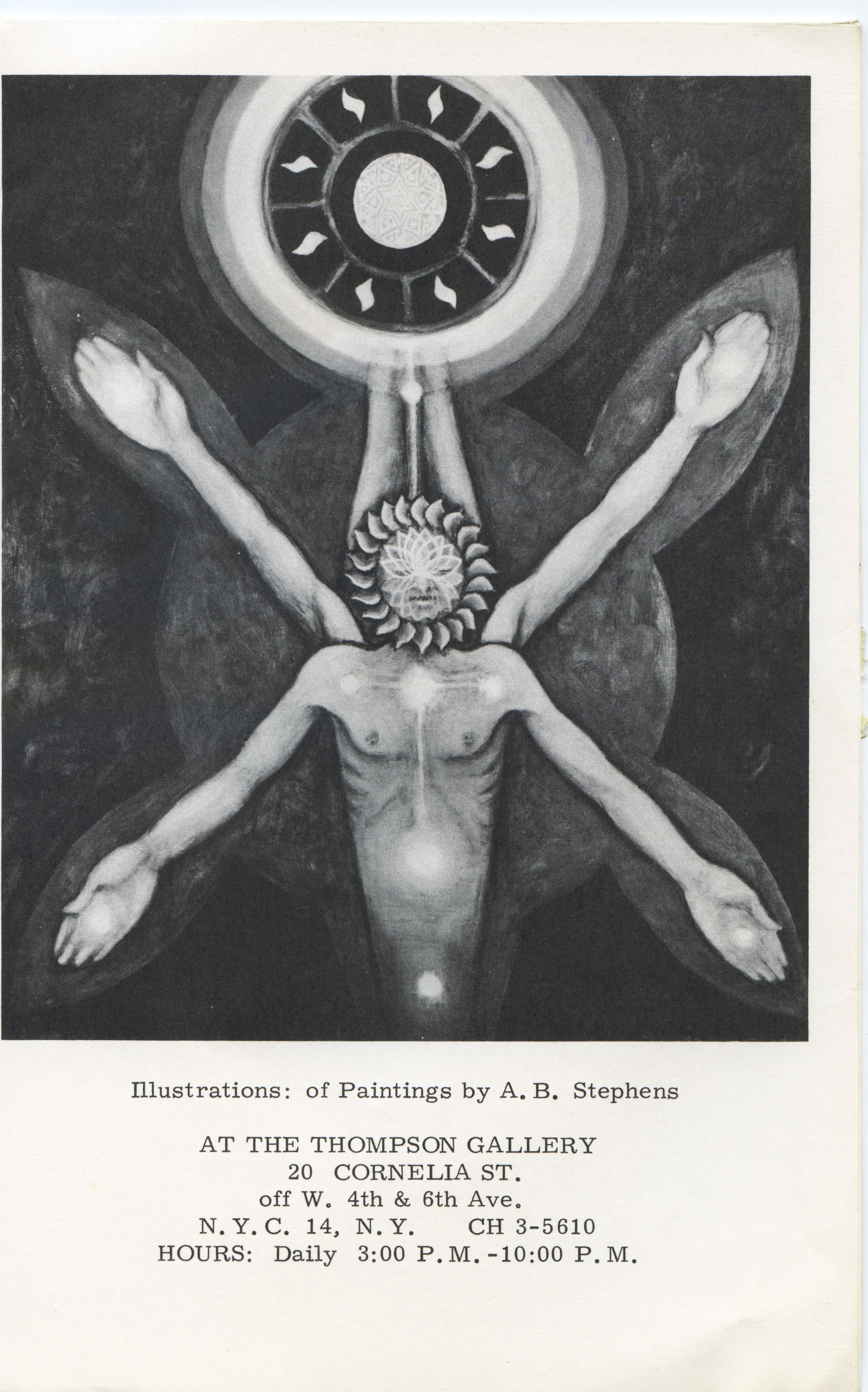
1964. Brochure Cover.
Cover image with Arran’s painting: “The Miraculous.”
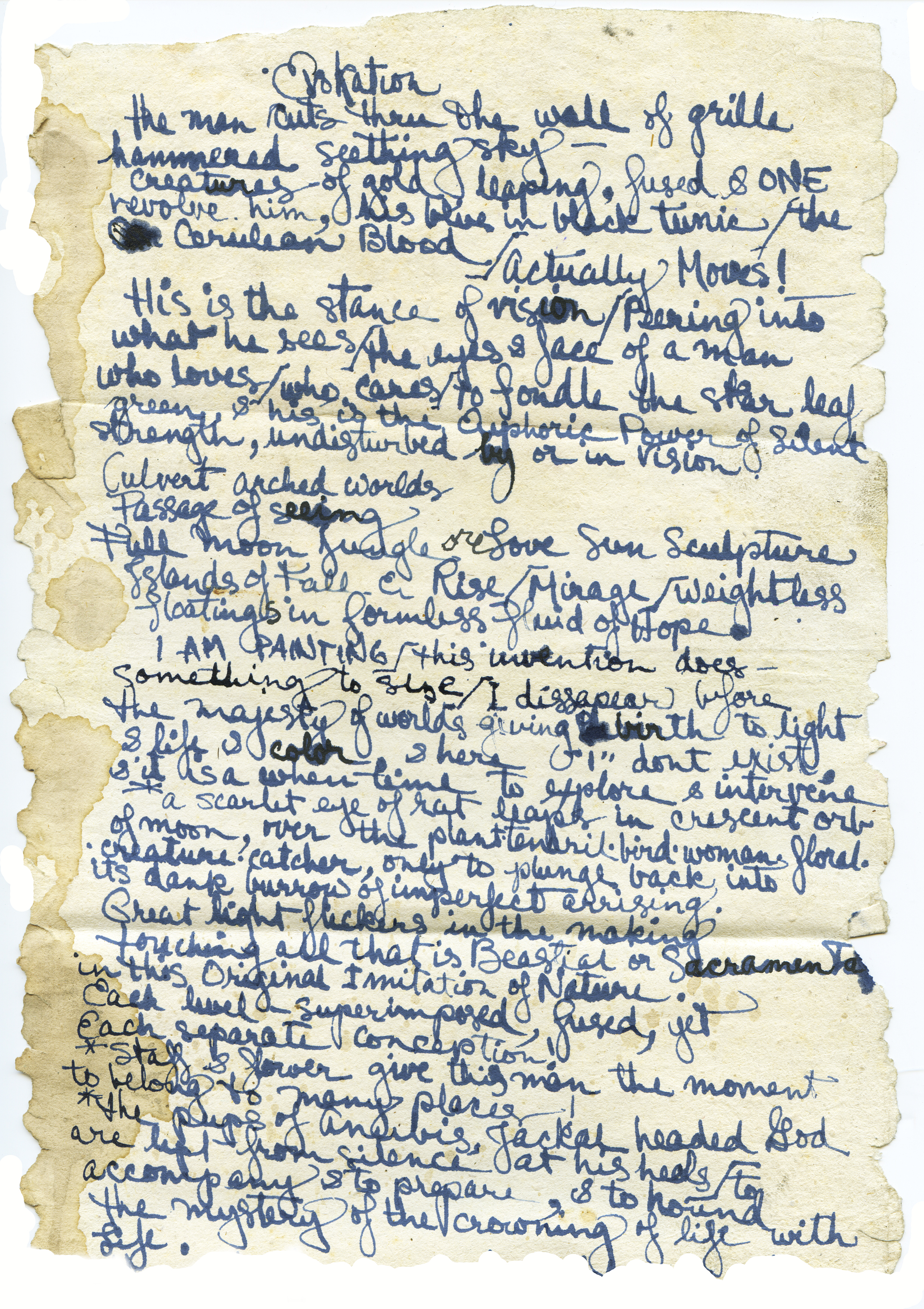
1964. Handwritten poem, page 1.
Arran’s poetry accompanying the exhibition of this important new work.
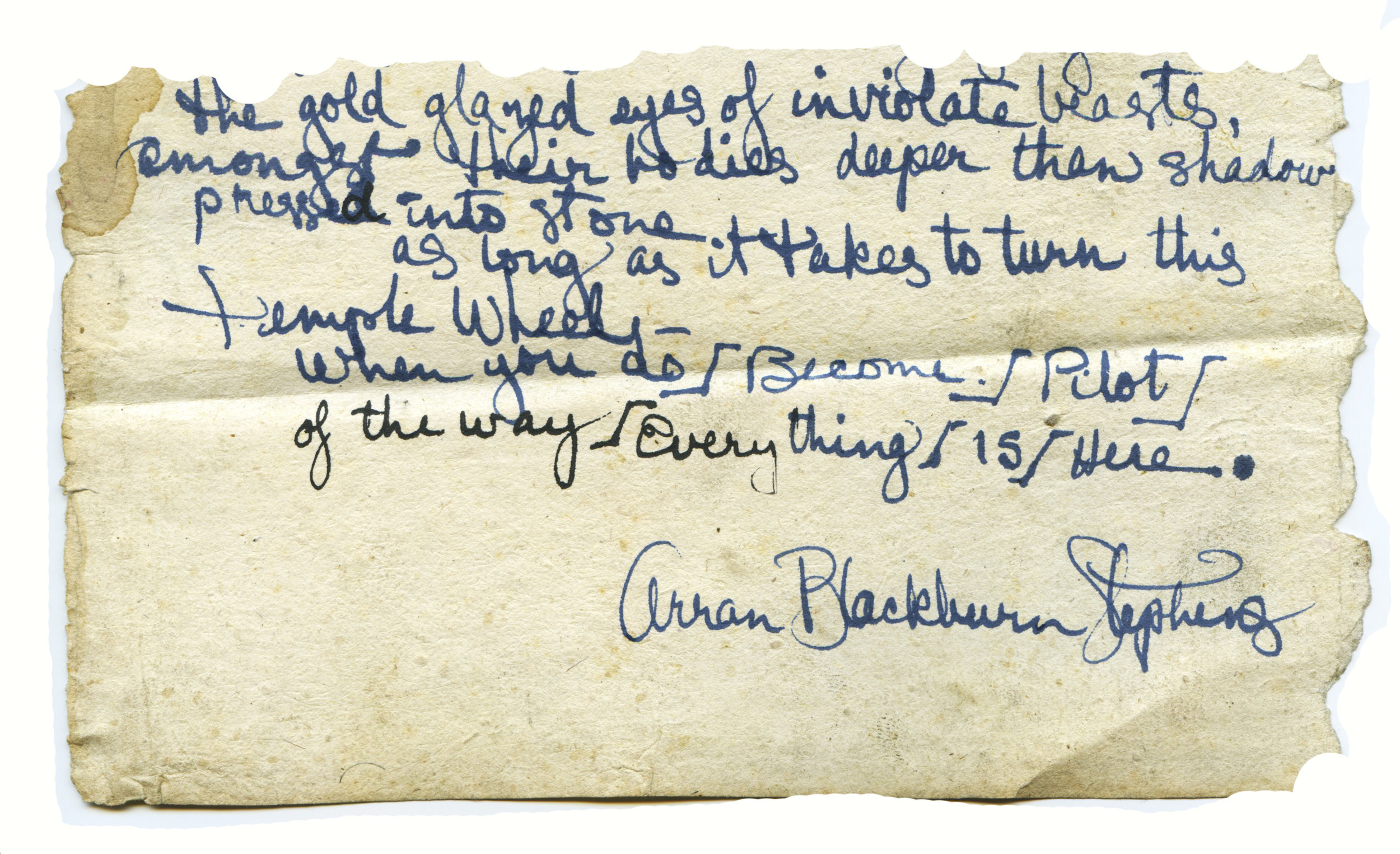
1964. Handwritten poem, page 2.
Page two of his handwritten poem.
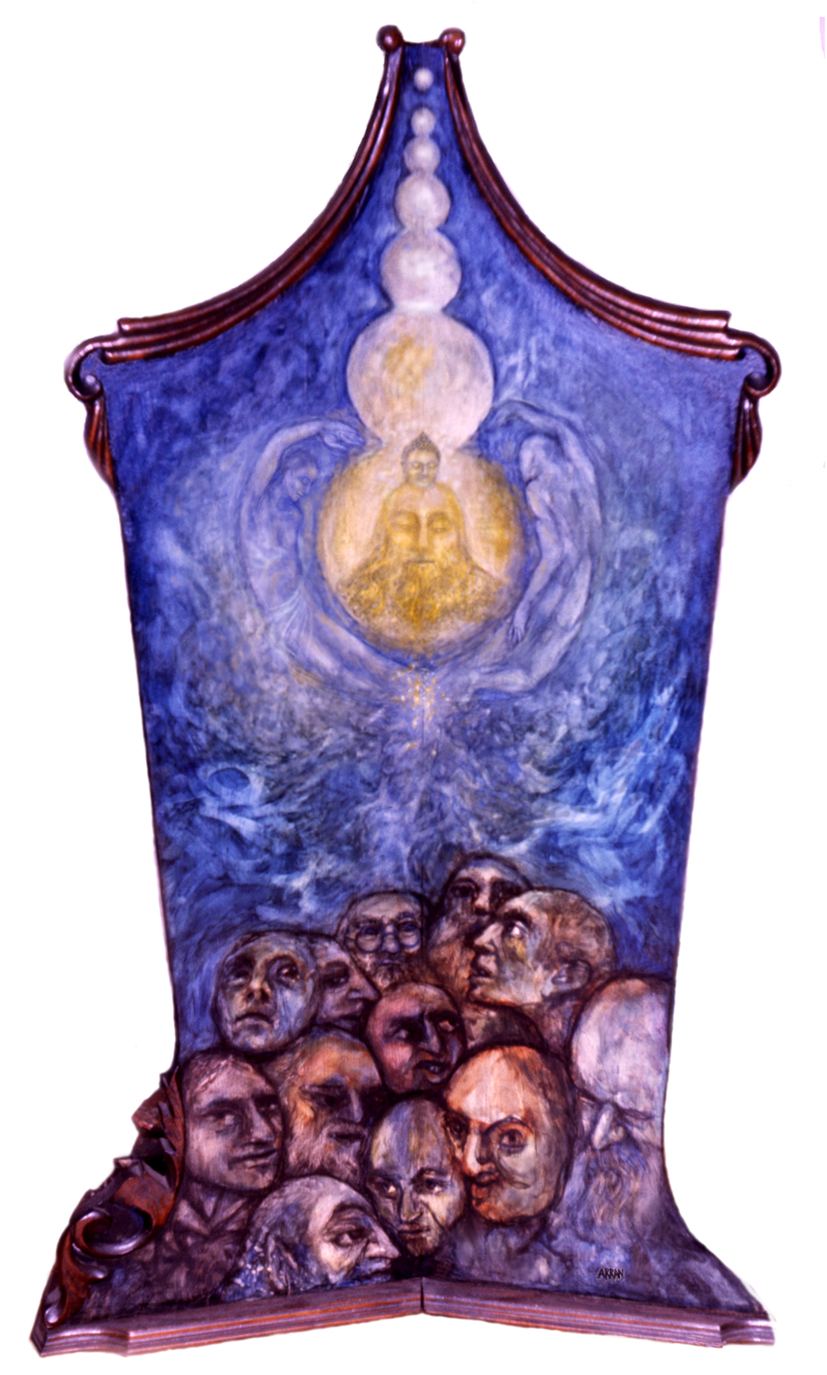
1964. Oil on Wooden Panel. 30” x 48”
A breakthrough painting for Arran, showing a newly developed interpretation of personal cosmology. His skill as a painter is evolving and this theme will grow in importance over his career. The painting depicts the general run of humanity, mostly concerned with self and power, greed, attachment, lust and anger. One man is different from the herd, and as he looks up, he beholds an amazing vision in the sky: an amalgamation of a Christ/or Buddha figure in the light within successive spheres of light ascending. Two guardians protect the Light.

1964. Graphite on Paper. 14” x 16”
After his move to New York City, Arran showed a developing concern with the worlds of inner life, bridging his poetical writings into his painting.
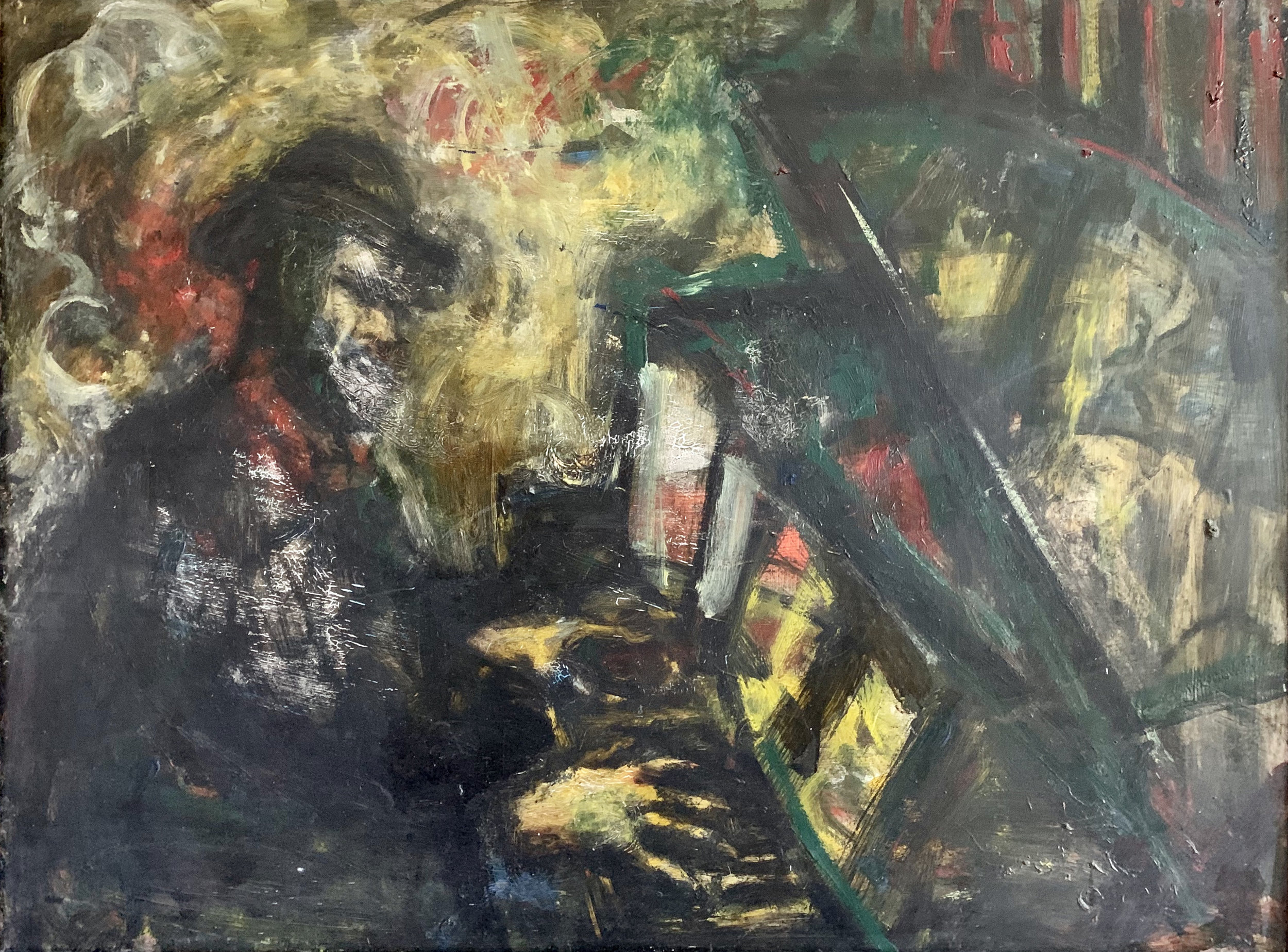
1964. Oil Painting. 36” x 48”
Arran’s tribute to the legendary bebop-based jazz pianist. In the early 1960’s—New York’s art, poetry and jazz scene fused into the Beat Movement.
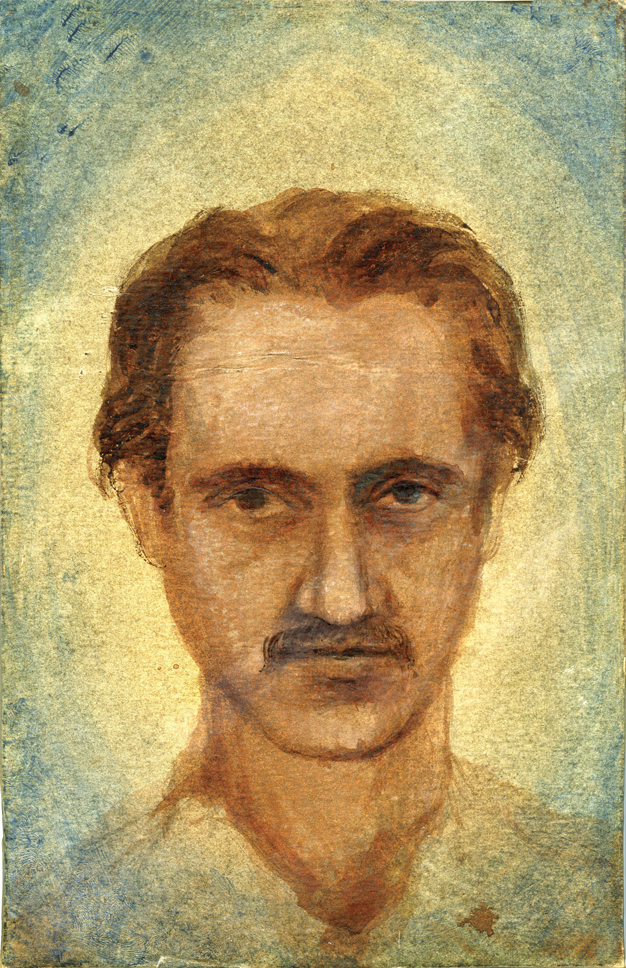
1964. Watercolor and Dry Media. 12” x 16”
Self-portraits are excellent tools for developing new ideas in the privacy of your own studio. This naturalist image diverts from the more expressionistic work of the previous year.
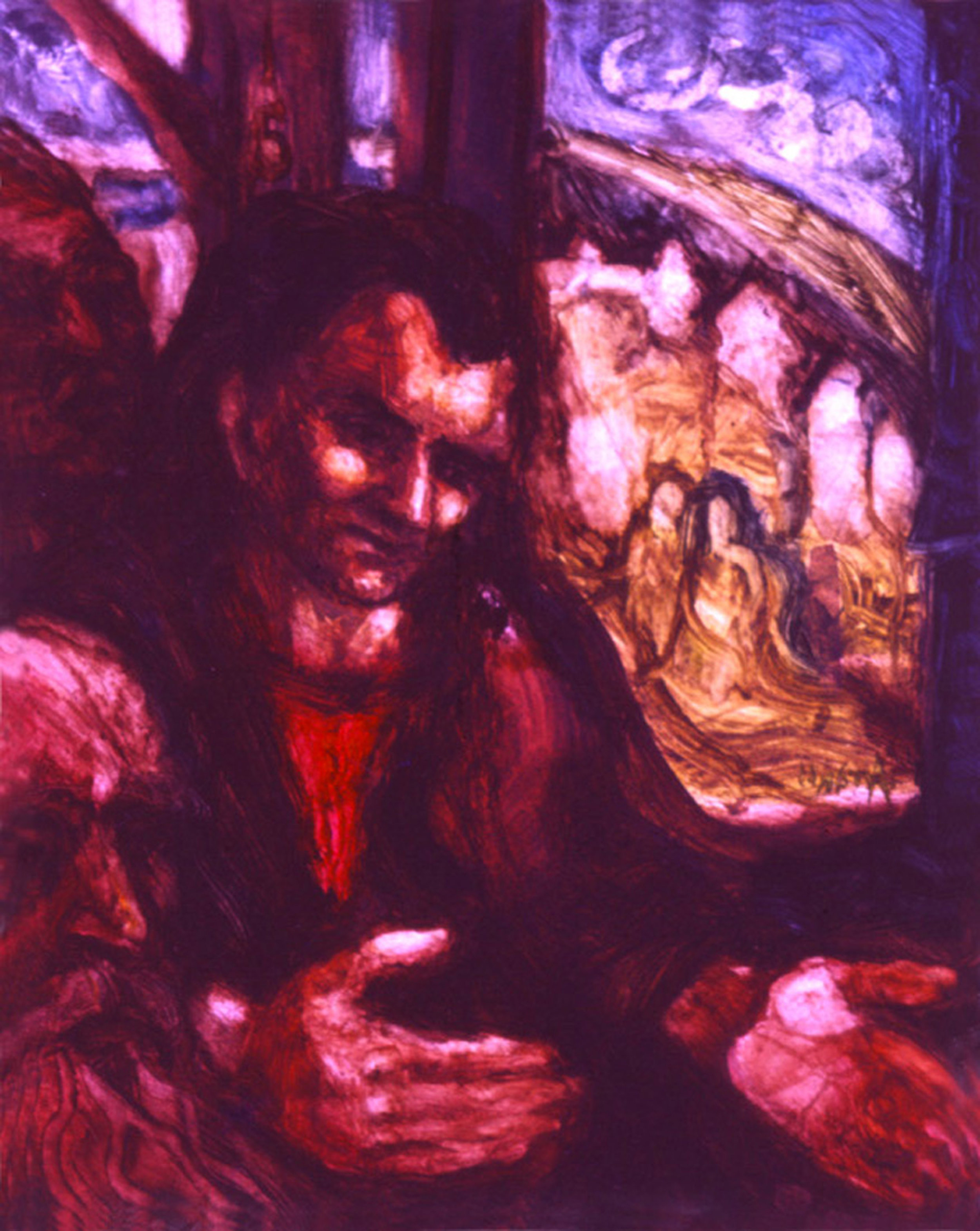
1964. Painting. 12” x 16”
This portrait explores a deep, expressionism. The background colors are quite luminous.
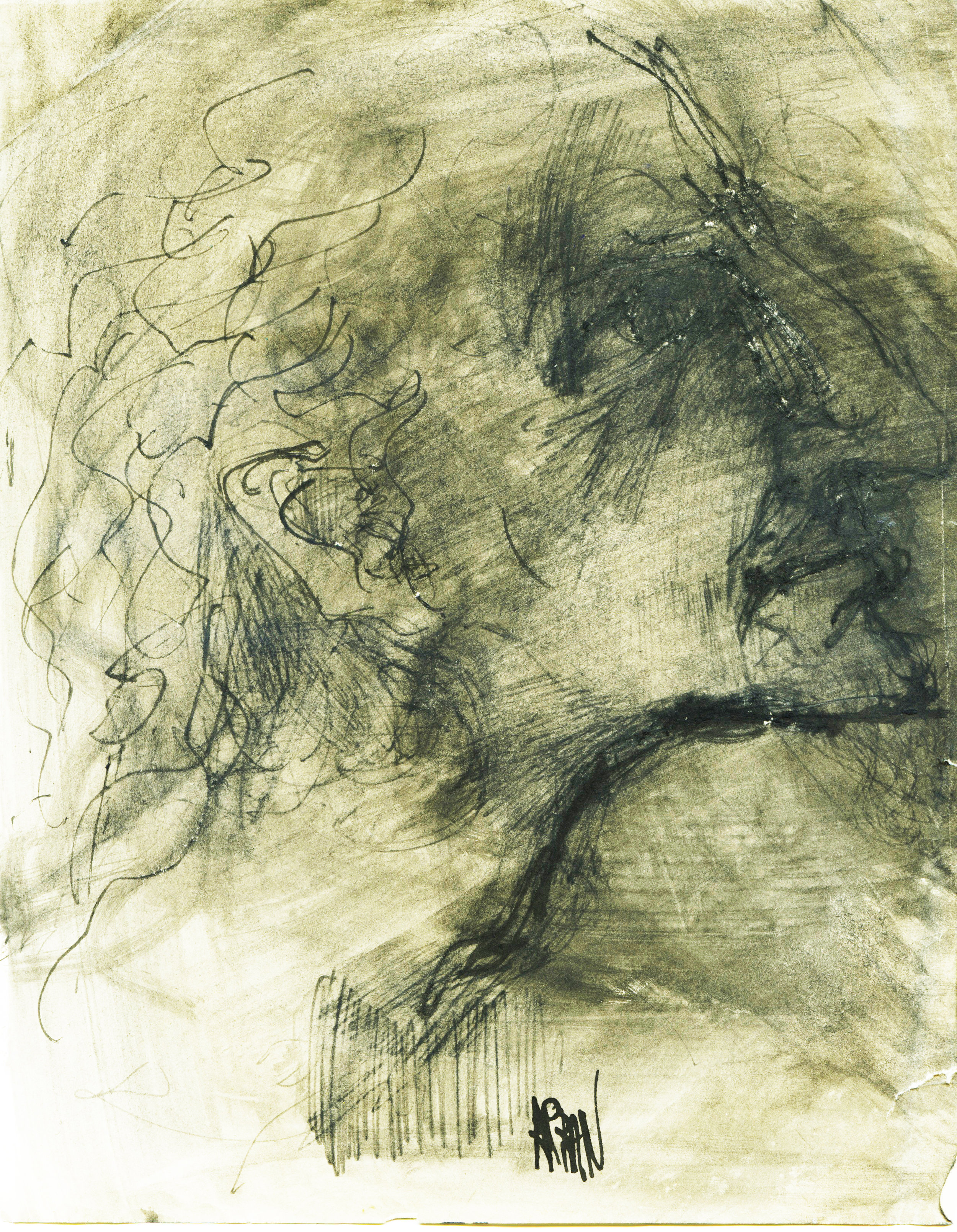
1964. Ink & wash on Paper. 12” x 16”
Exploring portraiture within a Renaissance form.
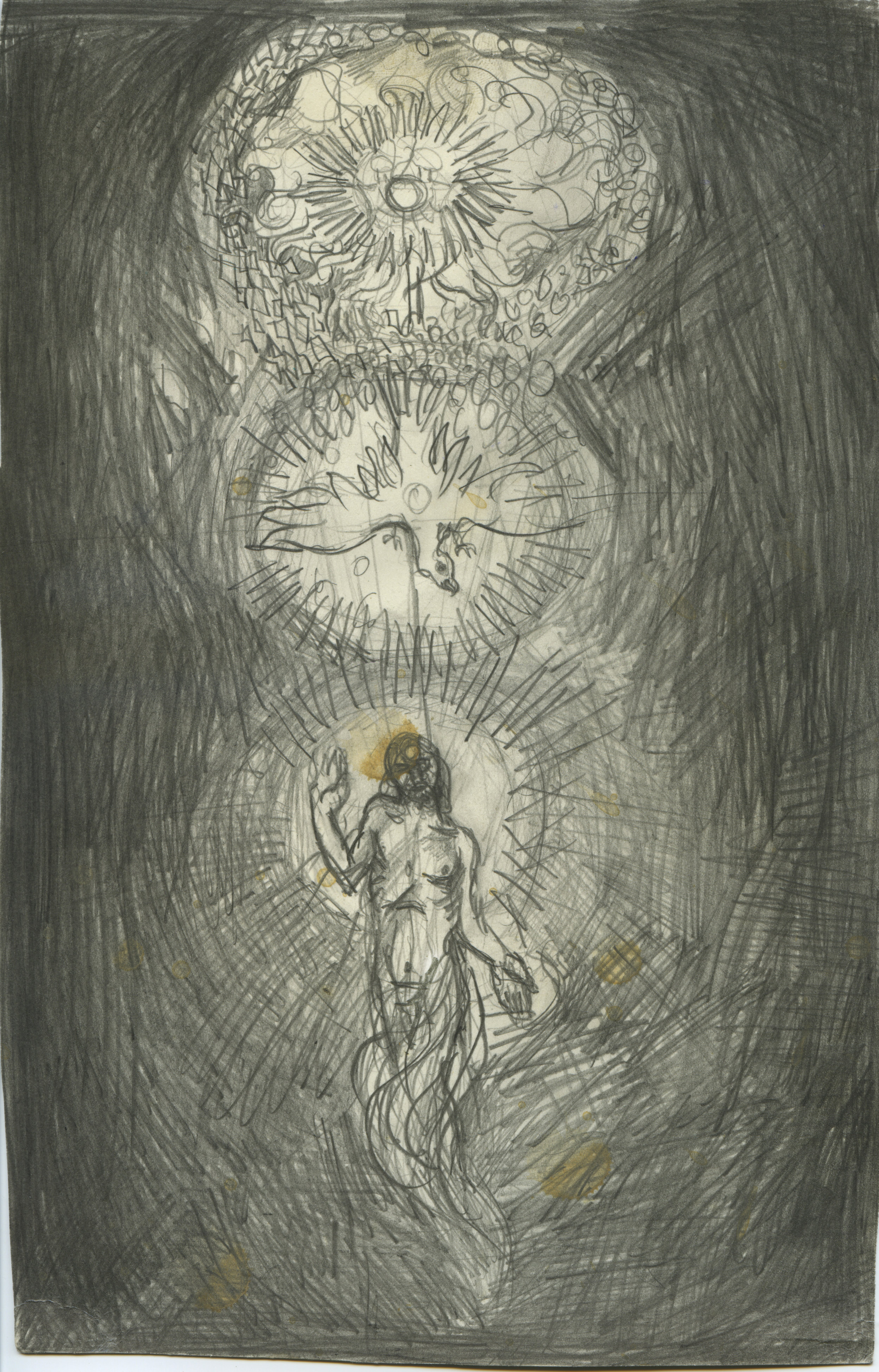
1964. Graphite on Paper. 12” x 16”
Arran’s pencil sketch exploring mystical iconography early in his career.
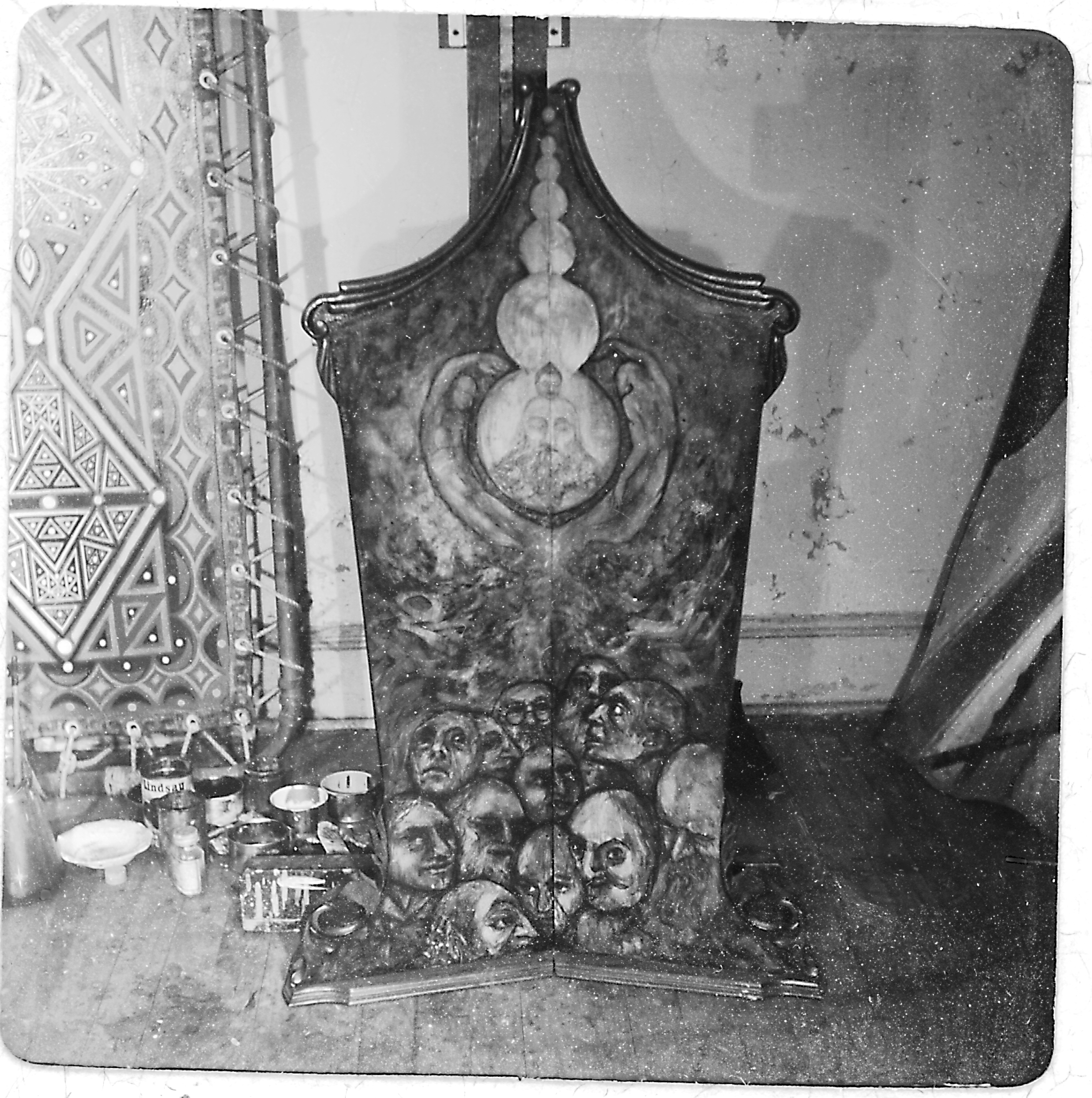
1964. Photo.
Photograph of Arran’s studio in New York, showing his paintings: “Trinity” and “Evokation.”
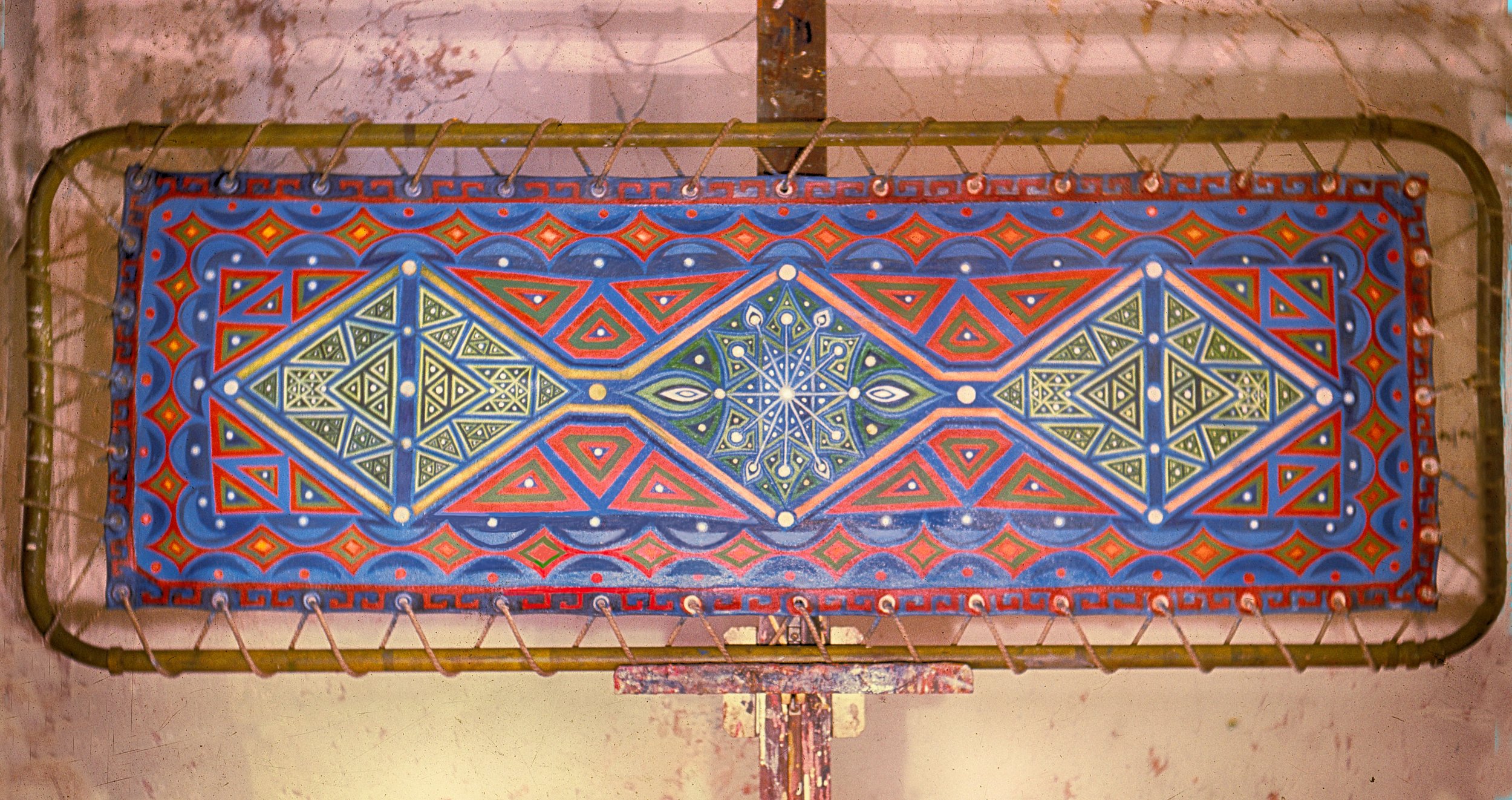
1964. Oil on Medical Stretcher. 36” x 72”
Pushing the edges of painting, this interpretation of traditional Middle Eastern carpet motifs adds Arran’s personal mystical iconography onto a new painting platform.
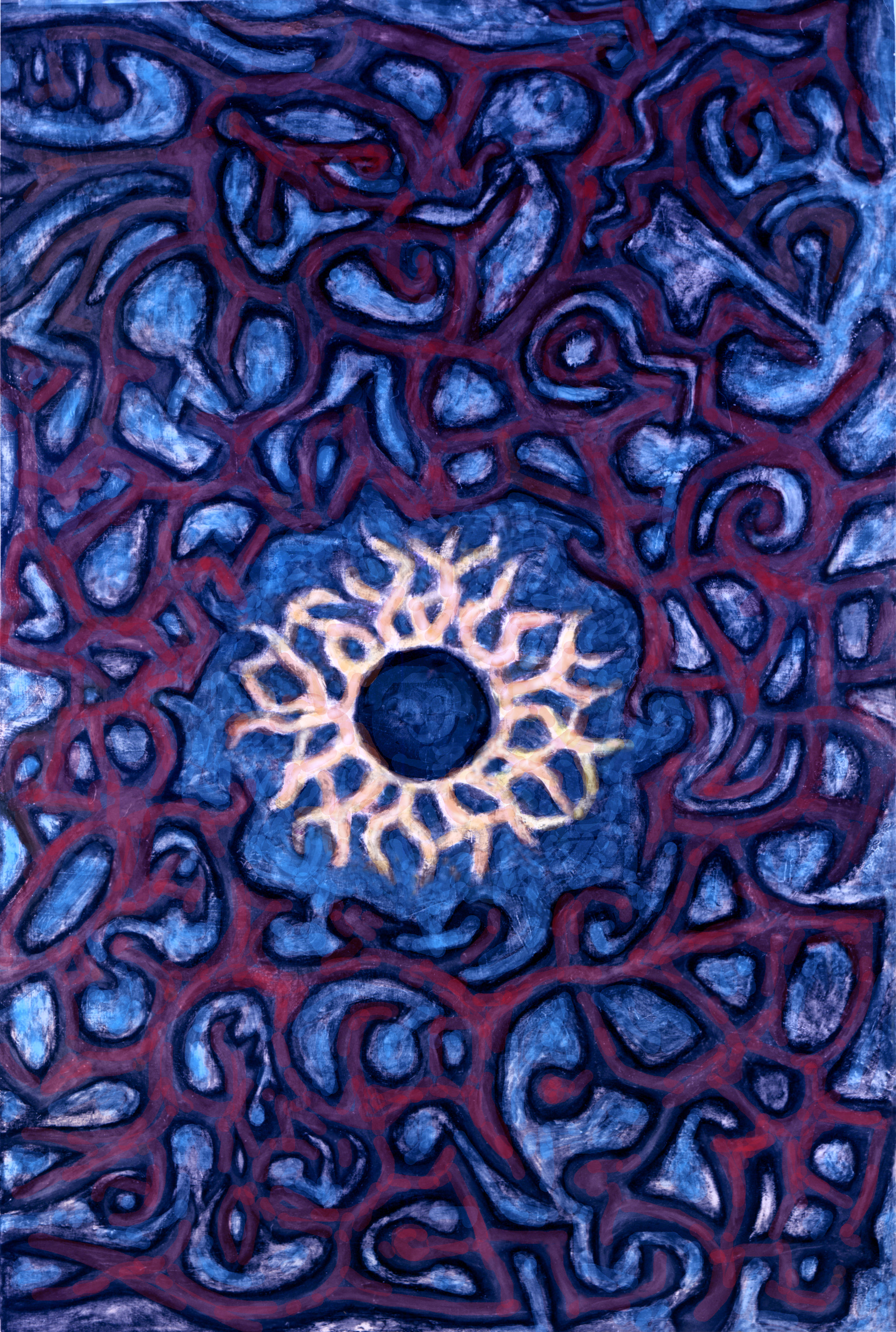
1964
Oil on canvas 24” x 36” Here, the artist explores madala with optic illusion
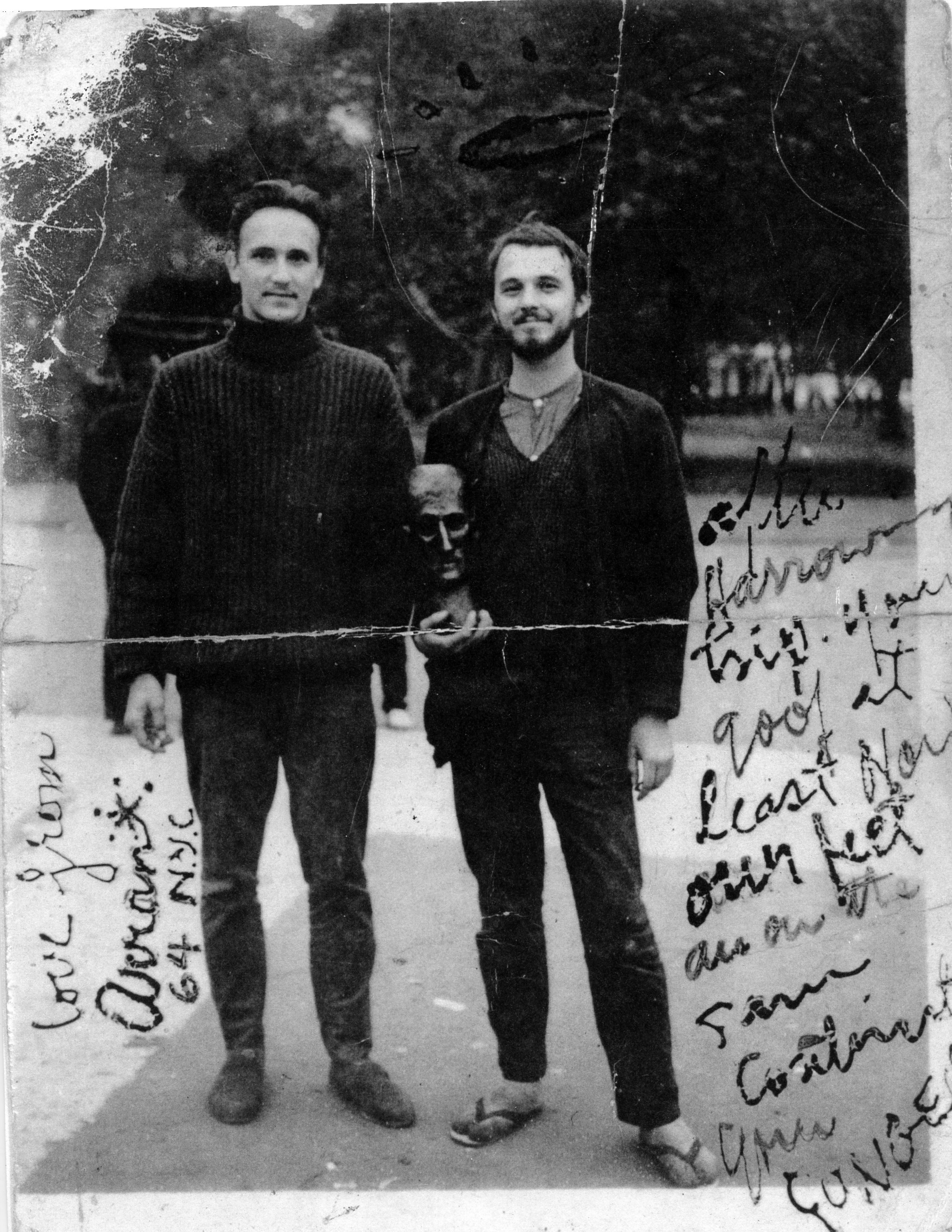
Godfrey Stephens is a well-known sculptor and painter, and he came to NYC to see his younger brother after having traveled around the world for several years, carving and painting. This photo marks the end of a troubled era for Arran and the turning point for a new life. In New York, Arran had been attending Gurdjieff and Ouspensky meetings, under the mentorship of Willem Nyland. Dissatisfied with mere intellectual philosophy, his search then led to Ramakrishna, Aurobindo, Rumi and Sant Kirpal Singh—a genuine living mystic. Out the window went his cigarettes, drugs, alcohol, non-veg food and everything else that stood between him and the Divine. It was the time of change, and his art began to reflect his aspirations. Life would be his canvas.
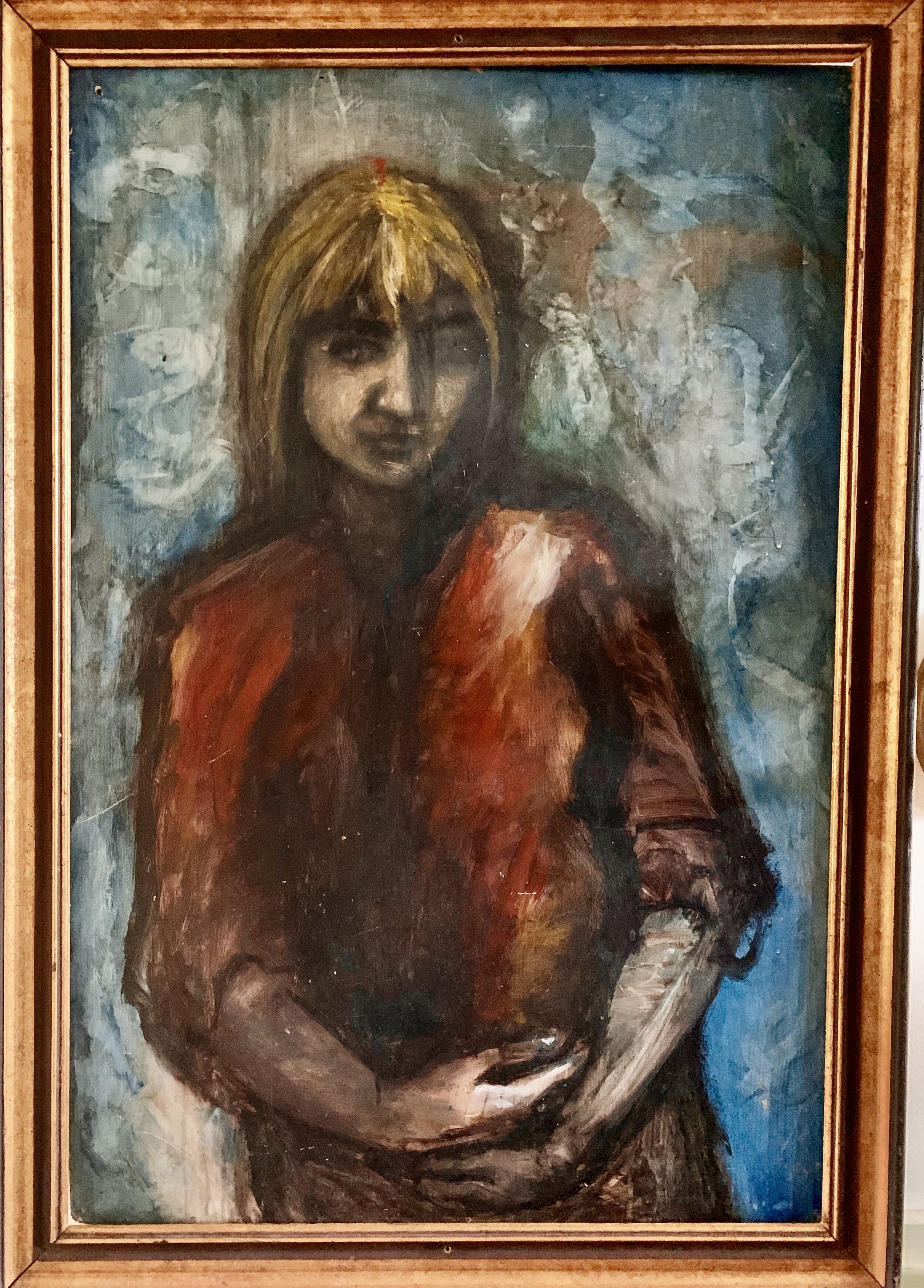
oil on masonite, 1962

oil on paper, NYC, 1964


OIl on Canvas, NYC, 1964

Pencil sketch on paper. NYC, 1964




























































1953. Graphite on Paper. 8.5” x11”
Displaying an early ability to portray strong character in a portrait, Arran made this drawing when he was nine years old. Perhaps it shows a premonition of an earlier life.
1956. Graphite on Paper. 9” x 12”
The themes of nature and wilderness showed up early in his life, growing up on Goldstream Berry Paradise Farm on Vancouver Island, Canada. When he and his older brother Godfrey used to play Cowboys and Indians, Arran always wanted to be the untamed Indian (First Nations). Godfrey studied carving under the famed Kwakwak’wa Chief, Mungo Martin. At 13, the farm was sold with considerable regret and the entire family moved to Los Angeles (Venice and Hollywood), California where his dad pursued his next career at age 60 to seek fame and fortune as a full-time songwriter, with the hopes that one day he would return to Goldstream and buy back the farm for his kids. That dream, however, was not fulfilled
1959. Oil Painting 12'“ x 16”
Arran’s first oil painting at 15 done in Hollywood, CA, displayed a unique invitation to enter into the blue forest’s depths.
1959. Oil on masonite. 16” x 36”
In his second-only oil painting, created in his cheap studio above Hollywood’s Music Box live theatre, Arran imagines a prophet-like being as he experiments with this painting medium. Other than his father, Rupert, the first actual wise man that he met and befriended was in 1961: Eden Ahbez, vegetarian, activist and author of the beautiful song, Nature Boy, made famous by Nat King Cole.
1960. Oil on masonite. 14” x 18”
His third oil painting. The road forward proved to be both a difficult but enlightening journey for the young artist, now living in Venice, CA. This poor photo is the only copy of this primitive painting. Inspired by Jack Kerouac’s book, “On the Road.”
1960. Oil on masonite. 18” x 24”
Angst and uncertainly in Venice. It was a time of possible anihliation by global nuclear war as the US and Russia were going at it hammer and tong; a troubling time for a deeply troubled teenager in search of the meaning of life. This overexposed photo is the only thing left of Arran’s third oil painting that depicts the last man on Earth in the aftermath of nuclear armaggedon. Arran begins to slip into a murky world.
1960. Oil Paintings.
At sixteen years in heart of the Beat Generation’s milieu, Arran sometimes slept in a cardboard box on Venice beach, sometimes foraged for food in a dumpster; it was a time of angst, exploration and depression. Considering the lives of great artists and poets, he thought perhaps the way to greatness was through suffering. Only much later would he discover that suffering and happiness do not come from without, but from within
A very existential look, searching for life’s meaning at seventeen—certainly reflecting troubled times.
1960. Oil Painting on masonite. 24” x 32”
An early portrait of prayer and longing—a theme that continues to develop over the years.
1960. Oil Painting on masonite. 36” x 48”
There was something inside, yearning to be let out and set free. A tornado of inquiry rose up from the depths of emotional seas. Arran went through a period of deep depression over the dissolution of his family, succumbed to substance abuse and entertained suicide. Interestingly, this painting was bought by an eminent Los Angeles psychiatrist for the princely sum of $100, which paid Arran’s rent and bought him some paint supplies.
1961. Photograph.
The artist at work on his “Venice Pier” painting.
1961. Oil Painting on masonite. 20” x 28”
Another emotional blossoming of expressionism, full of lively brushstrokes, pallet knife and graphic composition.
1961. Oil Painting. 24” x 36”
Arran’s portraiture of his good friend and sculptor, “Rodie” Roland March takes a dramatic turn with this expressionistic burst of emotional strength and exploratory color. According to the artist, this was his first significant portrait.
1961. Graphite on Paper. 16” x 20”
Expressionistic study of Harriet March and child Megan, graphic in composition.
1961. Oil Painting.
Arran painted this in his Venice, CA studio.
1961. India ink on Paper. 10” x 14”
Here Arran experiments with interjecting the energy of western expressionism into the traditions of austere, Zen-like Japanese design.
Oil on canvas, 1962, Vancouver.
This was painted in Vancouver, winter of 1962 at age 18. My unheated 4th floor studio apartment was in a rickety old wooden tenement building on Drake Street, so cold that the water froze in the sink and the toilet didn’t work. The painting reflects the times, it’s dark and moody. This was a difficult period of self discovery. From Vancouver, I hitchhiked down to San Francisco’s North Beach, had many unusual adventures, and landed in the thriving Beat/Art Scene where I lived and painted for the next two years, with a few more months in the wild Venice Beach Beat scene. During this time, I met Lawrence Ferlinghetti of City Lights Books, Allen Ginsberg, Eden Ahbez of Nature Boy fame, and many other unique poets, jazz musicians and artists. It’s a wonder I survived!
1962. Dry Media & Watercolor. 12” x 16”
More explorations into modernism, during a year’s stay in Vancouver. The dark frame of the hair draws the eye down through the colored washes layering the under-drawing of the face.
Black paint on paper
1963. Oil painting. 36” x 48”
The seed of life in human form. The mother and embryo are as though carved from granite. Only in later years when the artist established his own family did his works reflect more light, life, warmth and color.
1963. Pen & India Ink. 10” x 14”
While sitting in a cafe in North Beach, watching passersby, the artist sketched this sensitive portrayal of a brother on the street, thinking, “There, but by the grace of God go I.”
1963. Ink on Paper. 10” x 14”
Sketch for the painting of The Heirophant, displayed at San Francisco’s iconic Batman Gallery later that year. Inspired by the dramatic sight of an old Hasidic Rabbi walking along the Venice Beach boardwalk.
1963. Ink on Paper. 12” x 14”
Doodle drawing
1963. Ink on paper. 12” x 14”
An exploration of a portrait form.
1963. Lino Print.
Expressionistic imagery of our primal human condition.
1963. Oil Painting on linen. 48” x 60”
Arran first saw an old Rabbi walking down the Venice Boardwalk in 1961, and the image stayed with him, and he decided that in his mind’s eye, the Rabbi represented the Hierophant and decided to paint him in 1963 from memory. In the vocabulary of the Tarot, the Hierophant stands for tradition, convention and counsellor who will help in the education of the seeker.
1963. Poster.
Art opening announcement for Arran’s one-man show at the influential Batman Gallery in San Francisco. Featuring Arran’s painting: “Hierophant.”
1963. Art Construction. 24” x 48”
Arran’s experimentation with the collage/construction form using found-pieces, first developed by Georges Braque in the early 20thCentury. From an assemblage of different forms, an innovative new work emerged.
1963 Oil on Canvas 18” x 24”
India Ink on paper sketch, 1962
Photo of the artist at the SF mudflats, around the time of his first major exhibition at the Batman Gallery
1964. Oil Painting on canvas. 48” x 60”
Within the psychedelic filled background, we can see the influence of Hieronimus Bosch at play. The vision is complex and rich with symbolism, with a masterful exploration of worlds being born with life, color and mystery. The Anubis hounds of hell snap at the wayfarer’s heels, but the street he walks upon seems to be peeling away towards the depths. Is he poised to lift off the wheel and into the gold-blue sky? Who knows? Sadly, the artist destroyed this large canvas as it evoked too many memories of the darkest period in his life.
1964. Oil Painting.
Detail from Evokation.
1964. Painting on canvas.
Arran’s vison of cosmology begins to develop, partly based on his explorations into meditation and consciousness. One can see influences from both Tibetan, First Nations as well as Jewish mysticism.. in the background is the world turle (Turtle Island), how the First People’s myth of the world we live on. Hints of the Kabbalistic sephiroth and star of David are seen inside the mandala; the third eye opening in the center of the forehead, and the flowering of the light about the face indicate some awareness of the numinous essence of reality.
1964. LR from Brochure.
Inside image of Arran’s painting: “Evokation.”
1964. Brochure Introduction.
“Mystery magic, spirit born alive cloaked in shimmering garments of paint.” Introduction to Arran’s debut New York exhibition by poet, Bud Olderman.
1964. Brochure Cover.
Cover image with Arran’s painting: “The Miraculous.”
1964. Handwritten poem, page 1.
Arran’s poetry accompanying the exhibition of this important new work.
1964. Handwritten poem, page 2.
Page two of his handwritten poem.
1964. Oil on Wooden Panel. 30” x 48”
A breakthrough painting for Arran, showing a newly developed interpretation of personal cosmology. His skill as a painter is evolving and this theme will grow in importance over his career. The painting depicts the general run of humanity, mostly concerned with self and power, greed, attachment, lust and anger. One man is different from the herd, and as he looks up, he beholds an amazing vision in the sky: an amalgamation of a Christ/or Buddha figure in the light within successive spheres of light ascending. Two guardians protect the Light.
1964. Graphite on Paper. 14” x 16”
After his move to New York City, Arran showed a developing concern with the worlds of inner life, bridging his poetical writings into his painting.
1964. Oil Painting. 36” x 48”
Arran’s tribute to the legendary bebop-based jazz pianist. In the early 1960’s—New York’s art, poetry and jazz scene fused into the Beat Movement.
1964. Watercolor and Dry Media. 12” x 16”
Self-portraits are excellent tools for developing new ideas in the privacy of your own studio. This naturalist image diverts from the more expressionistic work of the previous year.
1964. Painting. 12” x 16”
This portrait explores a deep, expressionism. The background colors are quite luminous.
1964. Ink & wash on Paper. 12” x 16”
Exploring portraiture within a Renaissance form.
1964. Graphite on Paper. 12” x 16”
Arran’s pencil sketch exploring mystical iconography early in his career.
1964. Photo.
Photograph of Arran’s studio in New York, showing his paintings: “Trinity” and “Evokation.”
1964. Oil on Medical Stretcher. 36” x 72”
Pushing the edges of painting, this interpretation of traditional Middle Eastern carpet motifs adds Arran’s personal mystical iconography onto a new painting platform.
1964
Oil on canvas 24” x 36” Here, the artist explores madala with optic illusion
Godfrey Stephens is a well-known sculptor and painter, and he came to NYC to see his younger brother after having traveled around the world for several years, carving and painting. This photo marks the end of a troubled era for Arran and the turning point for a new life. In New York, Arran had been attending Gurdjieff and Ouspensky meetings, under the mentorship of Willem Nyland. Dissatisfied with mere intellectual philosophy, his search then led to Ramakrishna, Aurobindo, Rumi and Sant Kirpal Singh—a genuine living mystic. Out the window went his cigarettes, drugs, alcohol, non-veg food and everything else that stood between him and the Divine. It was the time of change, and his art began to reflect his aspirations. Life would be his canvas.
oil on masonite, 1962
oil on paper, NYC, 1964
OIl on Canvas, NYC, 1964
Pencil sketch on paper. NYC, 1964